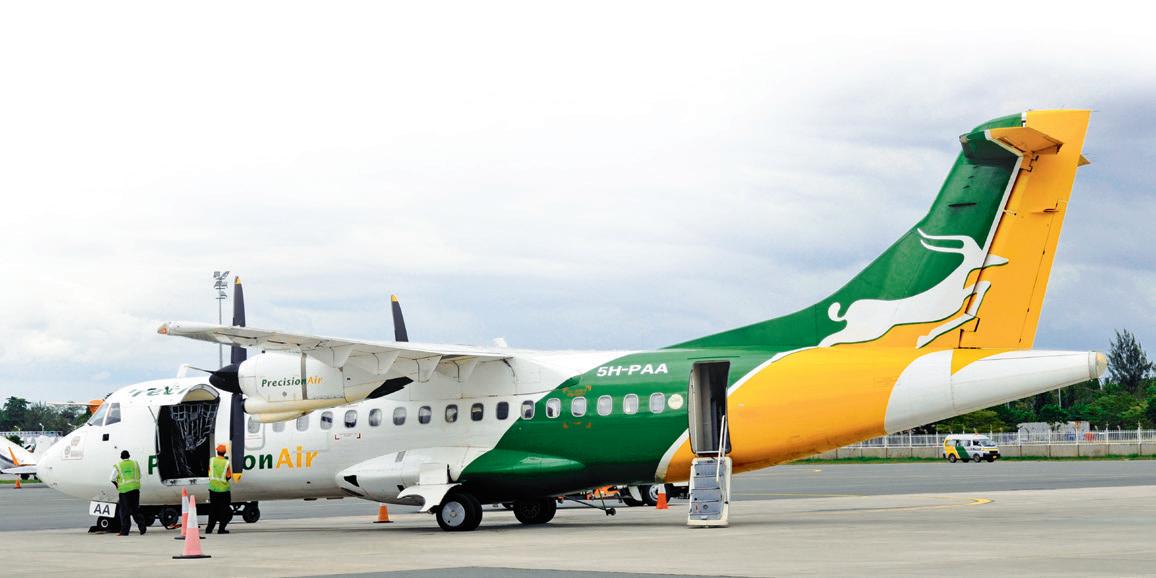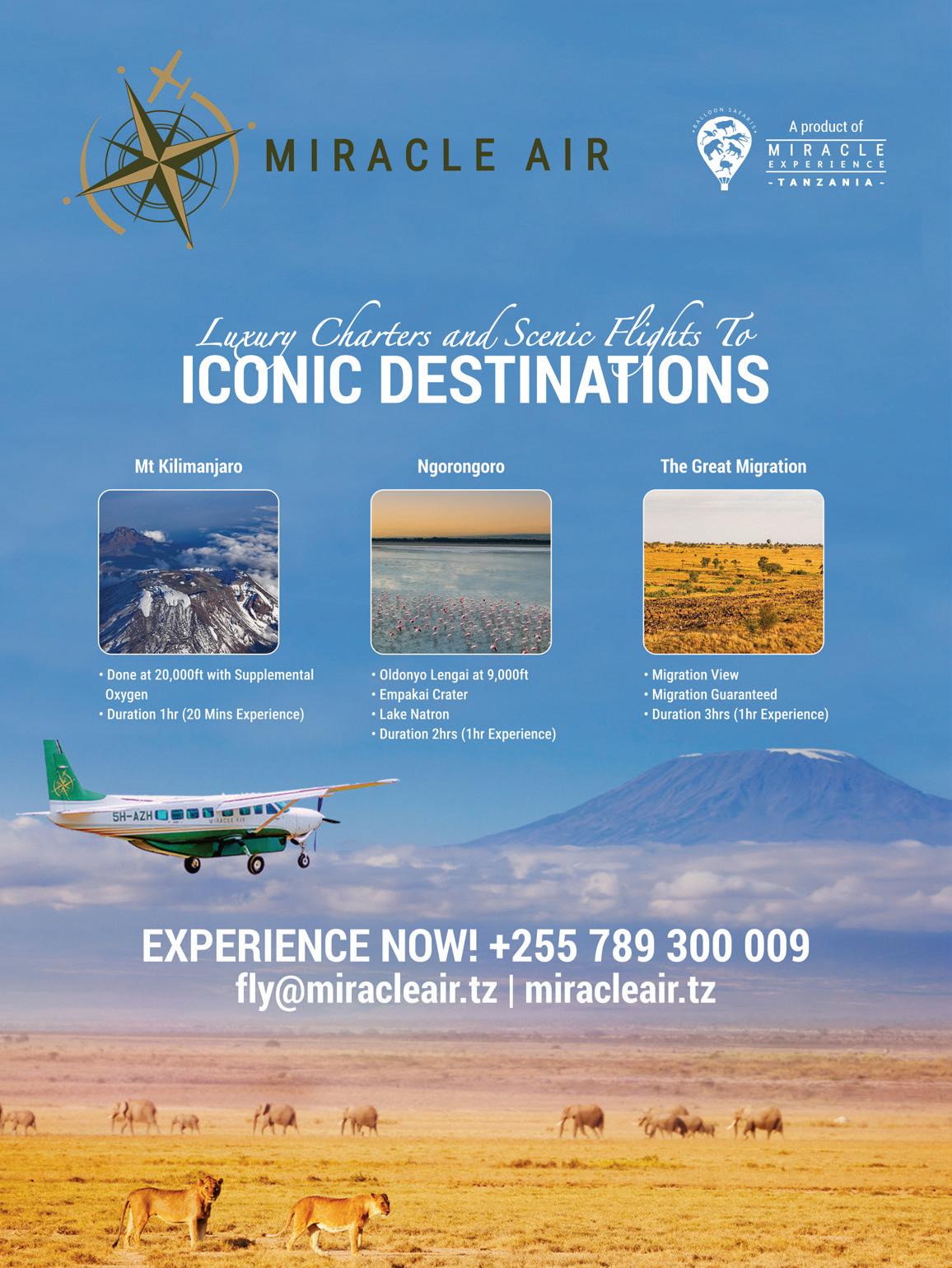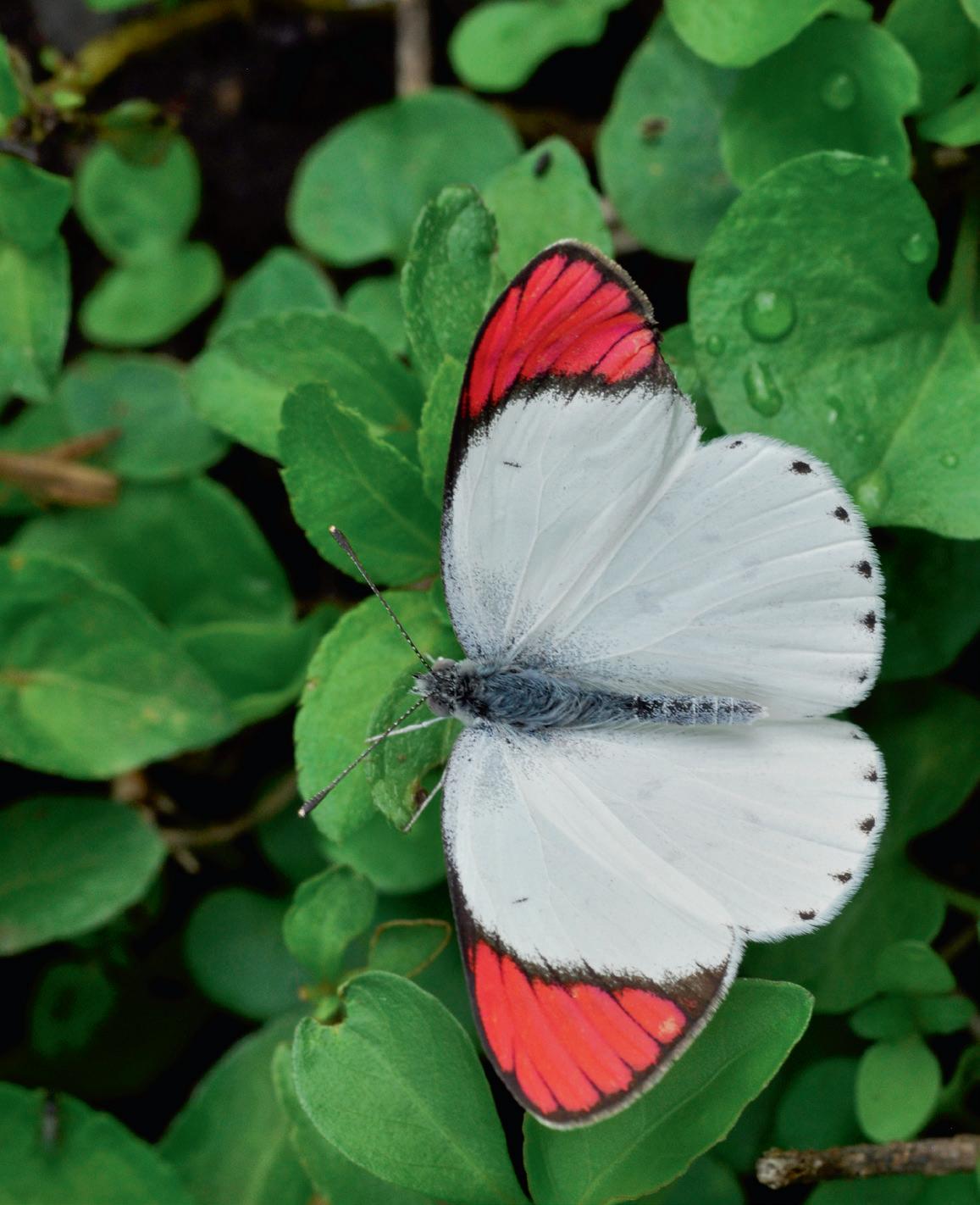

Winged wonders


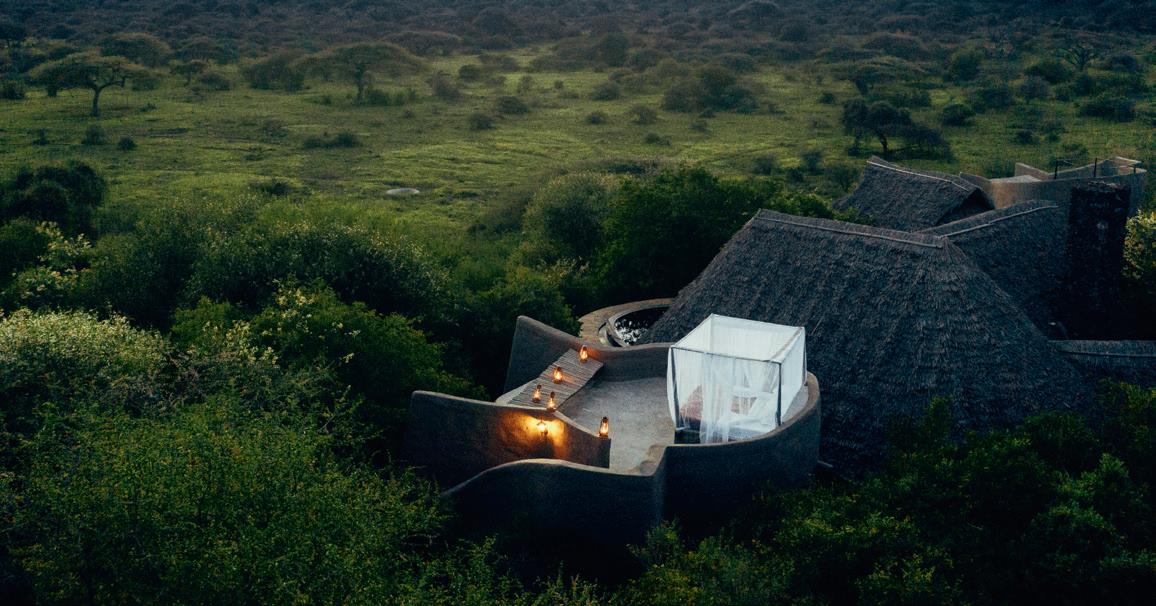

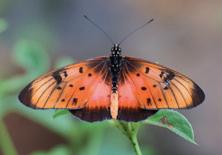

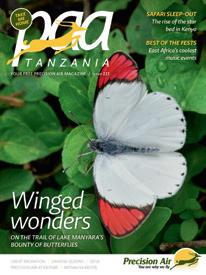
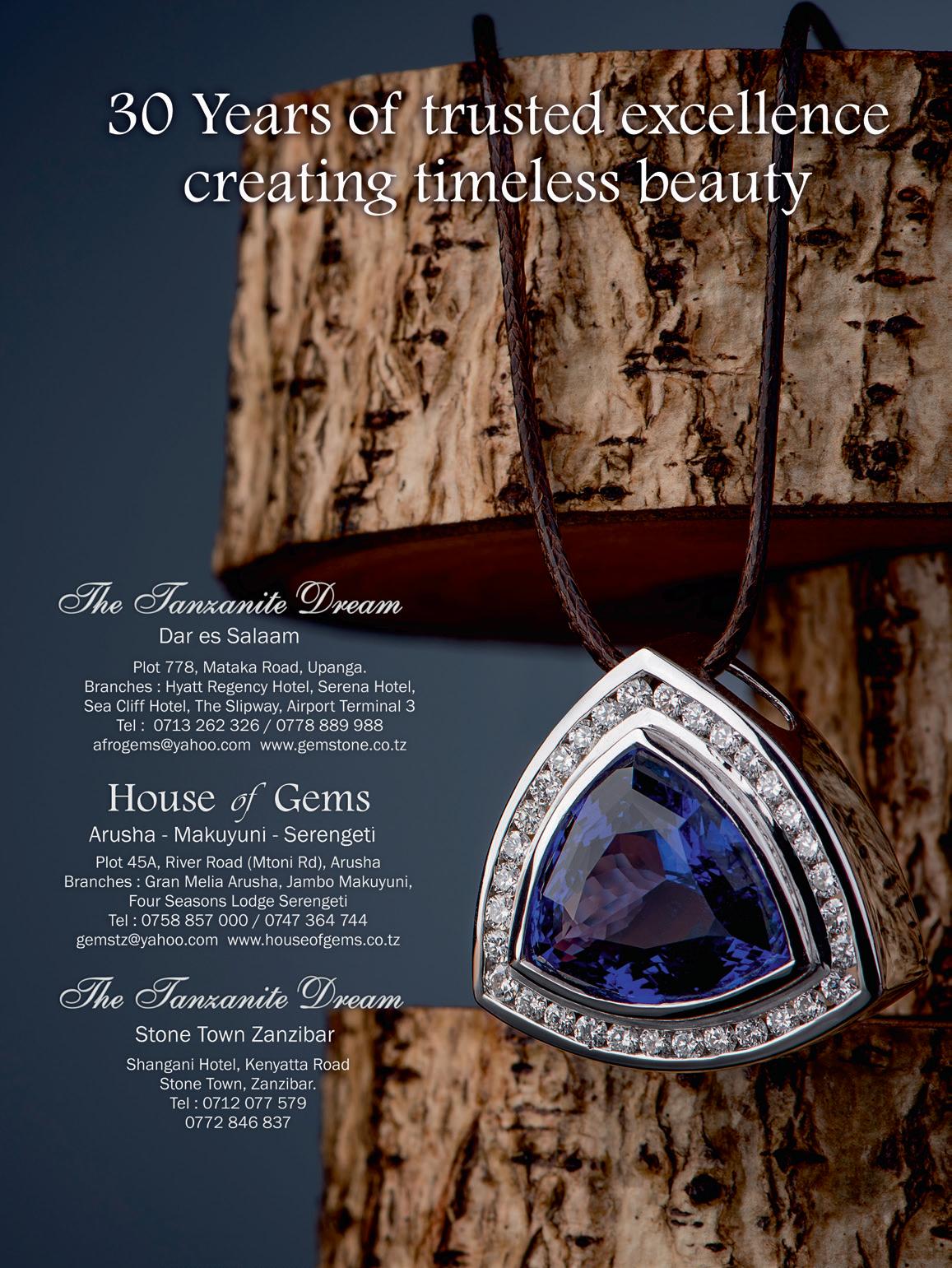
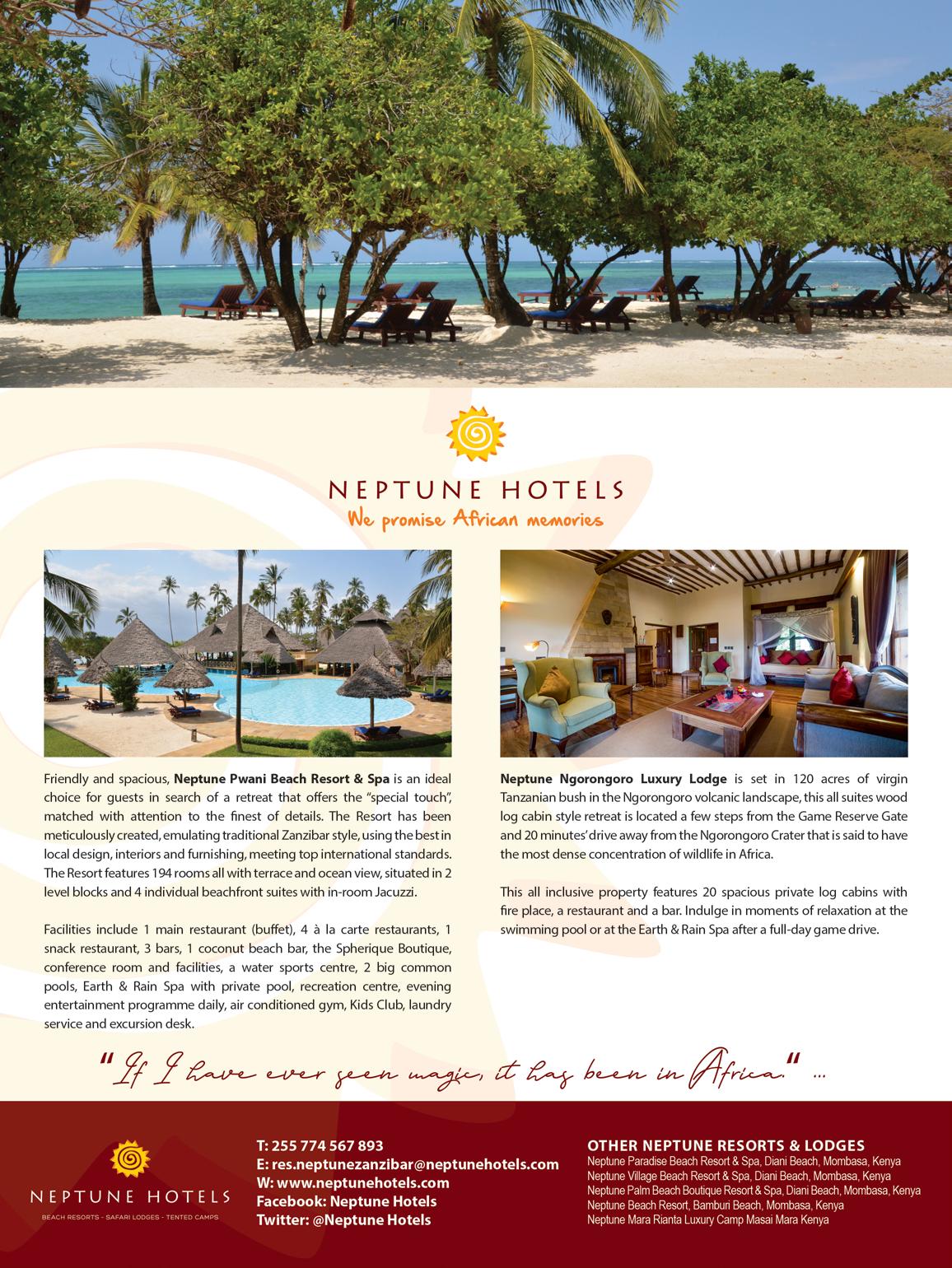
Precision Air Services Plc
Diamond Plaza
PO Box 70770, Dar es Salaam, Tanzania
Tel: +255 (0)22 219 1000
Fax: +255 (0)22 286 0725 www.precisionairtz.com
Marketing and Corporate Communications
Manager: Hillary Mremi
Email: hmremi@precisionairtz.com
Paa Tanzania Magazine is published by: Land & Marine Publications (Tanzania) Ltd 5th floor, Josam House Plot Number 16, Mikocheni Area Along Coca-Cola Road, Dar es Salaam Tel: +255 686 118 816 www.landmarine.com
ADVERTISING: Godfrey S. Urassa Tel: +255 (0)686 118 816 (WhatsApp)
Email: godfreyurassa@landmarine.com
General enquiries
Email: paa-tz@landmarine.org
EDITOR: Mark Edwards
Email: markedwards@landmarine.com
Head office:
Land & Marine Publications Ltd
6 The Square, Ipswich, Suffolk, IP5 3SL UK Tel: +44 (0)1206 752902
Email: publishing@landmarine.com www.landmarine.org
The contents and opinions expressed in this publication are not necessarily those of the editor, or any other organisation associated with this publication. While every care is taken to ensure accuracy in preparing the magazine, the Publisher and Precision Air assume no responsibility or liability for any inaccuracies or omissions. All submitted material is accepted on the understanding that the material can be edited, amended or abridged for publication. ©2025 Land & Marine Publications (Tanzania) Ltd.
Subscribe
Request your e-version subscription by emailing: subscribe@landmarine.org
Keep in touch
www.precisionairtz.com
Facebook: @Precisionair Tanzania
Instagram: @Precisionairtz
LinkedIn: Precision Air Tanzania
X: @PrecisionAirTZ
TikTok: @_precisionairtz
YouTube: @PrecisionAirOfficial
A promising future
It is my great pleasure to welcome you onboard your Precision Air flight today and to the latest edition of our inflight magazine, Paa Tanzania.
As is clear from our slogan, ‘You are why we fly’, Precision Air is forever grateful for our passengers’ contributions to the airline’s success. It is therefore especially pleasing to see that the latest figures show an increase in Precision Air passenger numbers. Last year’s numbers are almost double those recorded amid the covid slump and the aftermath effects including supply chain issues caused by the lockdown. We are on a road to recovery.
I see the growth potential of Tanzania’s expanding aviation sector as key to Precision Air’s recovery. My involvement in this pivotal sector has increased with two recent appointments that give me plenty of personal satisfaction, but owe much to the progress we are making at Precision Air.
I have been selected as the Chairperson of the TCAA Training Fund Committee and Vice Chairperson of the Tanzania Aviation Operators Association. I believe these prestigious appointments owe much to Precision Air’s reputation for its rigorous and comprehensive training programs, particularly for Pilots, Engineers, Technicians and Cabin Crew as well as the great role Precision Air has played in the aviation industry for the past 32 years.
The airline’s Precision Air Training Centre (PTC) is approved by the Tanzania Civil Aviation Authority (TCAA) and aims to equip graduates with the knowledge and skills necessary for the airline industry, ensuring they are prepared for the competitive job market. We welcome you to enroll to our training programs.
Our expertly trained staff raise the bar in customer service and are an important part of our route to revolver along with cost optimisation, emphasising Safety above all and making sure our flights are always on time as per industry standards.
Thank you for playing your part in our progress.
You Are Why We Fly
Patrick Mwanri Managing Director and CEO Precision Air Services Plc

Our Serengeti flights are back
The long dry season is upon us once again and that means Precision Air is resuming its flights to the Seronera airstrip in the heart of the Serengeti.
From June 14 to October 16, we will be connecting intrepid passengers every day between Dar es Salaam and the world-famous national park.
That four-month period is considered by many experts to represent the prime period to see the incredible density of iconic wildlife the park is renowned for. The days are sunny and warm, and the bush thins out making wildlife easier to spot.
The months also mark one of the most dramatic stages in the Great Migration, the never-ending pilgrimage of millions of wildebeest and other large herbivores towards new feeding grounds.
The dry weather sends the herd north to the permanent water sources of the Grumeti River in the Serengeti, and over the Kenyan border to the Mara River. The river crossings are as dramatic as
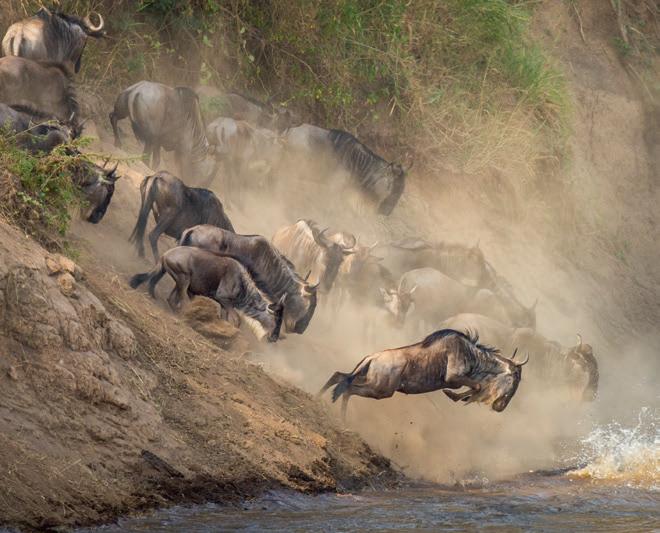
they are dangerous. Predator peril is everywhere with crocodiles lurking underwater and lions, leopards, and hyenas in wait on the banks. It is one of the world’s most spectacular natural sights.
Book your flight today through our website a www.precisionairtz.com
Your safety is our priority
Precision Air operates an Approved Training Organization (ATO) that focuses on empowering our crew with essential skills, including first aid. These images were taken at a recent training session demonstrate Precision’s commitment to passenger safety.
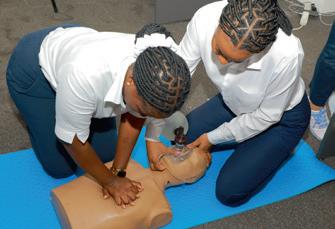
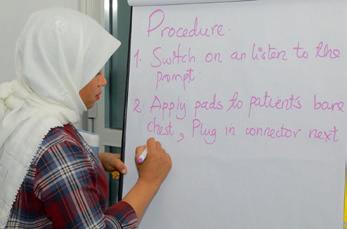
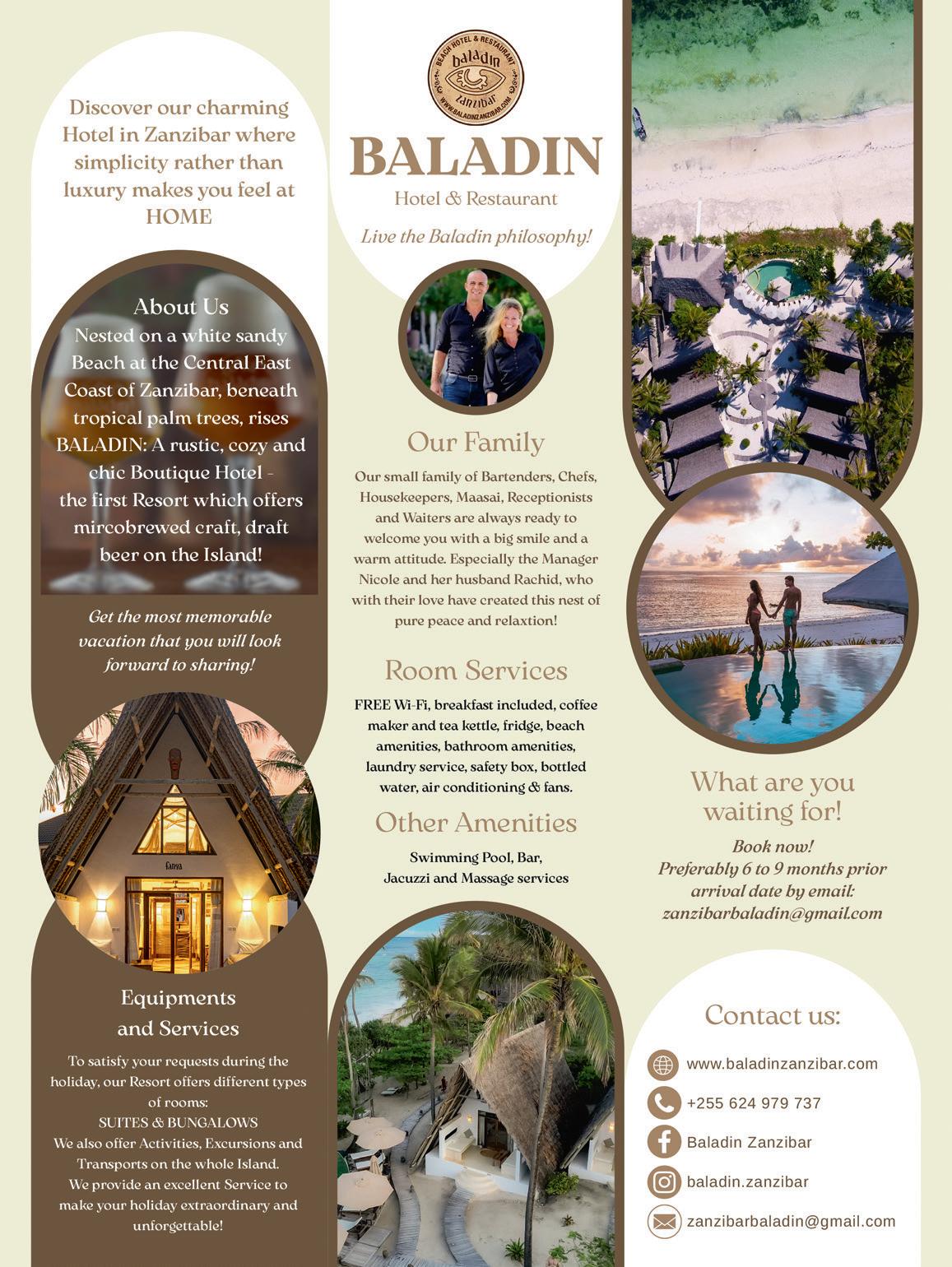
East Africa’s coolest music festivals
Bond with the crowds in a shared love of music and discover your new favourite artist at these unmissable events.
Sauti za Busara
What is it? Now in its 22nd year, Sauti za Busara (the name means in ‘Sounds of Wisdom’ in K iswahili) has grown to become one of Africa’s premier music events. More than 500 artists from over 60 countries have performed here over the years. The vast majority have been African with care taken to spotlight new genres and talent along with traditional artists to reflect the richness and connectivity of music on the continent. Among the features that set this festival apart from the rest is its historic venue. The Old Fort, built by Omani Arabs in the late 17th century, provides an attractive and atmospheric backdrop to each night of music.
Where is it? Stone Town, Unguja (Zanzibar Island). The two main stages for music performances are within The Old Fort, but there are fringe events taking place across Stone Town including a carnival street parade.
Next event: February 6 to 8, 2026 Past headliners: Taarab legend Bi Kidude, singeli star Baba Kash and Zambia-born rapper and singer Sampa The Great.
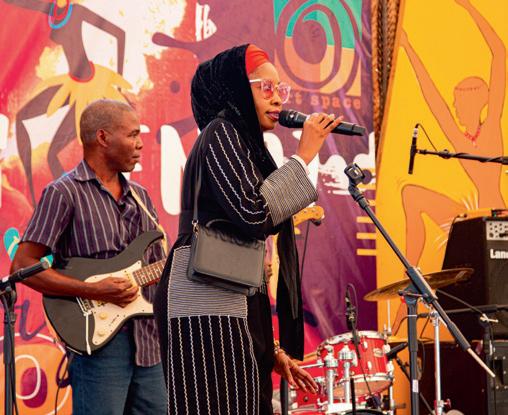
What do people say about it?
“[The festival has become] a vibrant platform for emerging talent and a celebration of Africa’s cultural heritage. Sauti za Busara has also boosted Zanzibar’s tourism, offering a unique space for unity and creative exchange. It stands as a powerful reminder of music’s ability to connect and inspire across cultures.” (Lorenz
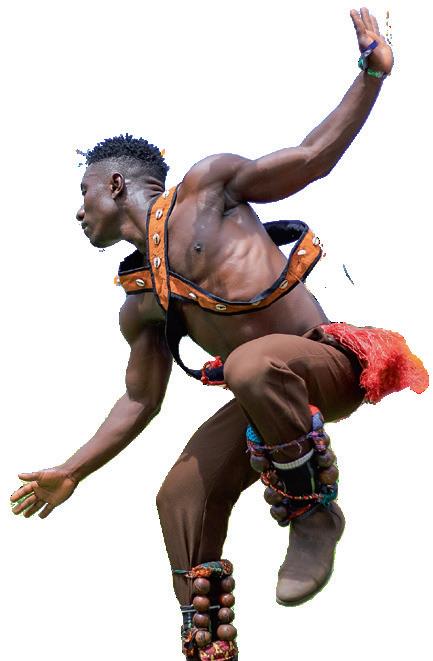
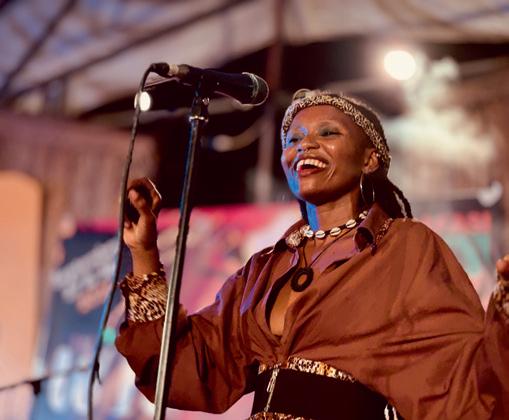
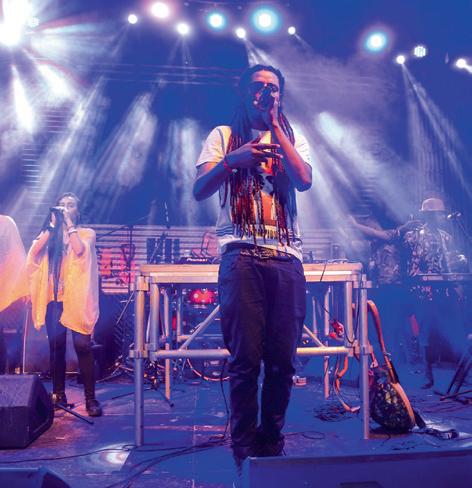
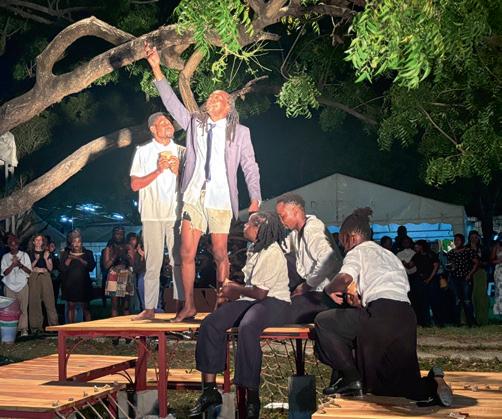
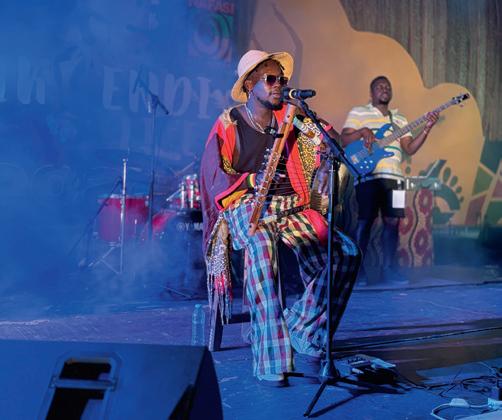
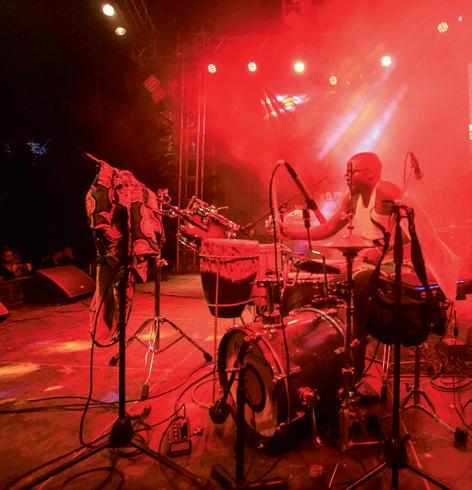
Wikiendi Live
What is it? Wikiendi Live began as a bi-monthly live performance showcase staged at Dar es Salaam cultural hub Nafasi Arts Space. It has since become an annual two-day extravaganza that attracts more than 1,000 people each year to enjoy performances by the cream of local talent in music, poetry and dance. There are artisan markets and children’s activities during the day before two consecutive nights of performances on the Nafasi outdoor stage.
Where is it? Nafasi Arts Space, Mikocheni, Dar es Salaam.
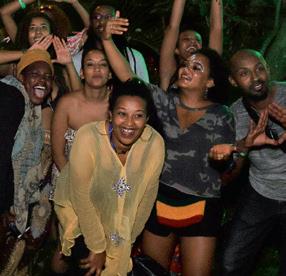
Next event: September 26 to 27, 2025. From 10am to midnight on both days.
Past headliners: Singeli specialist Man Fongo, Tanzanian singer Abeneko, and jazz collective the Seghito Band.
What do people say about it? ““Wikiendi Live is more than a festival, it’s a place where strangers meet and become one big dancing family. It’s a communal celebration of creativity, community, and culture, reviving and fusing traditional African rhythms and new sounds.” (Nafasi Arts Space managing director Lilian Hipolyte Mushi)
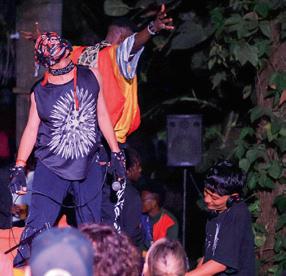
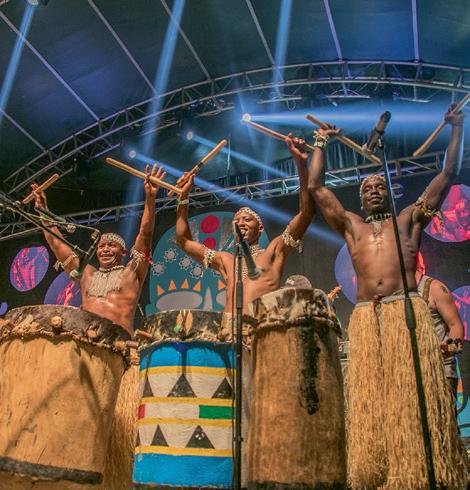

Stars of the stage at Sauti za Busara
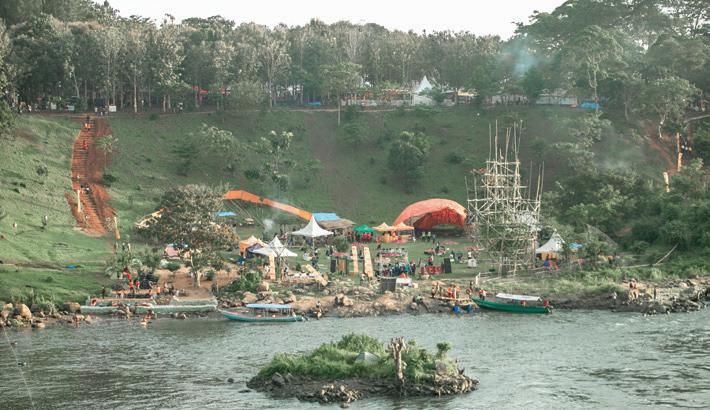
Nyege Nyege Festival
What is it? Kampala-based record label, Nyege Nyege Tapes has been championing underground East African electronic music since 2014. Many of the label’s leading lights and future stars can be seen performing live at annual Nyege Nyege Festival, which is marking its 10th anniversary this year and is considered Africa’s largest music festival with last year’s event attracting 60,000 attendees. The line-up for the two-day event focuses on forward-thinking DJs and musicians from East
Dar es Salaam’s DIY urban dance movement singeli with its release ‘Sounds of Sisso’ and the genre’s latest acts are always a crowd favourite.
Where is it? The festival takes place in Jinja, on Uganda’s banks of the River Nile.
Next event? July 19 and 20, 2025. Past performers: Tanzanian ‘cyber-singeli’ rising star DJ Travella, British DJ Jamz Supernova, Ugandan DJ Kampire and Kampala-based genre-bending electro artist Authentically Plastic.
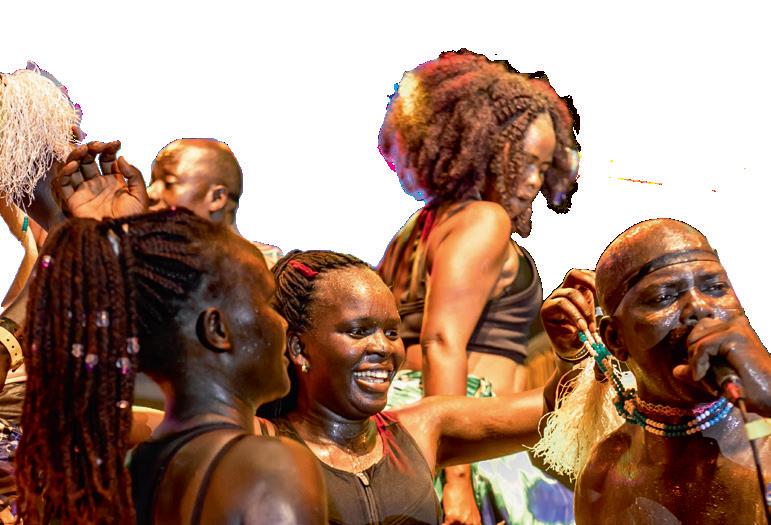

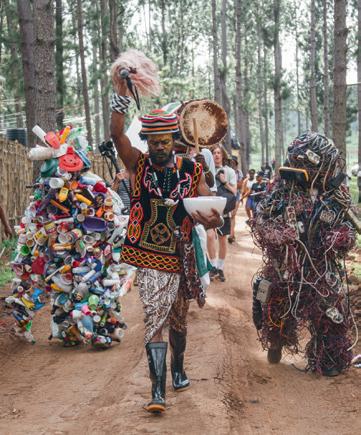


Furaha City
What is it? Those who like their music festivals to feature a host of multi-million-selling artists should put Furaha City in their digital calendars. This one-day event in the Kenyan capital Nairobi attracts East Africa’s music mega-stars. The star-wattage was so intense at last year’s event that it blew up in a series of backstage ego wars that resulted in headliner Diamond Platnumz not performing. Still the organisers are teasing that this December the event will be bigger than ever with an even more extensive line-up of top-tier talent.
Where is it? Held at the Nairobi Polo Grounds Polo Club in Jamhuri Park, off Ngong Road. Next event: December 7, 2025.
Past headliners: Tanzanian stars Zuchu and Rayvanny along with Kenyan rapper Khaligraph Jones were among the 2024 line-up. What do people say about it: “It was a night to remember at the Nairobi Polo Club Grounds! The crowd’s energy was fire.” (Furaha City Festival Facebook page)
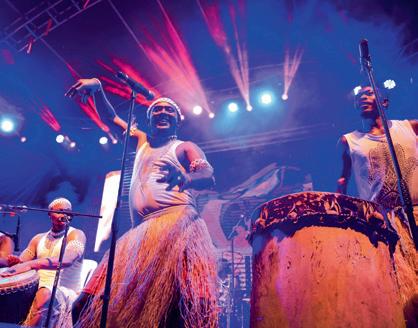

Beneath the Baobabs Festival
What is it? This Kenyan festival sees in the new year with two unforgettable days and nights of music across four stages. Thousands of music fans dance under the stars to a musical line-up showcases genres such as Afrohouse, hip-hop and drum and bass. The setting is as spectacular as the music with the 50-acre site carefully arranged among the baobab forest on a plateau above the emerald waters of Takaungu Creek in the coastal resort of Kilifi. As the first carbon neutral festival in Africa, Beneath the Baobabs ensures that it leaves no trace of its presence once the dancing is done. Where is it? Kilifi, midway between Mombasa and Malindi on the Kenyan coast. When is it? December 30, 2025, to January 1, 2026.
Past performers: Kenyan musicians Blinky Bill, Suraj, Ochungulo Family, and Faizal Mostrixx. They’ve also had international acts such as South African DJ Da Capo and US producer Nickodemus.
What do people say about it: “Join thousands of festival-goers as music fills the air [and] keeps you dancing beneath the starlit sky. Experience the enchantment of art installations, connect with like-minded souls, and embrace the spirit of East Africa. Welcome to a world where music and nature collide.” (Beneath the Baobabs Festival website)
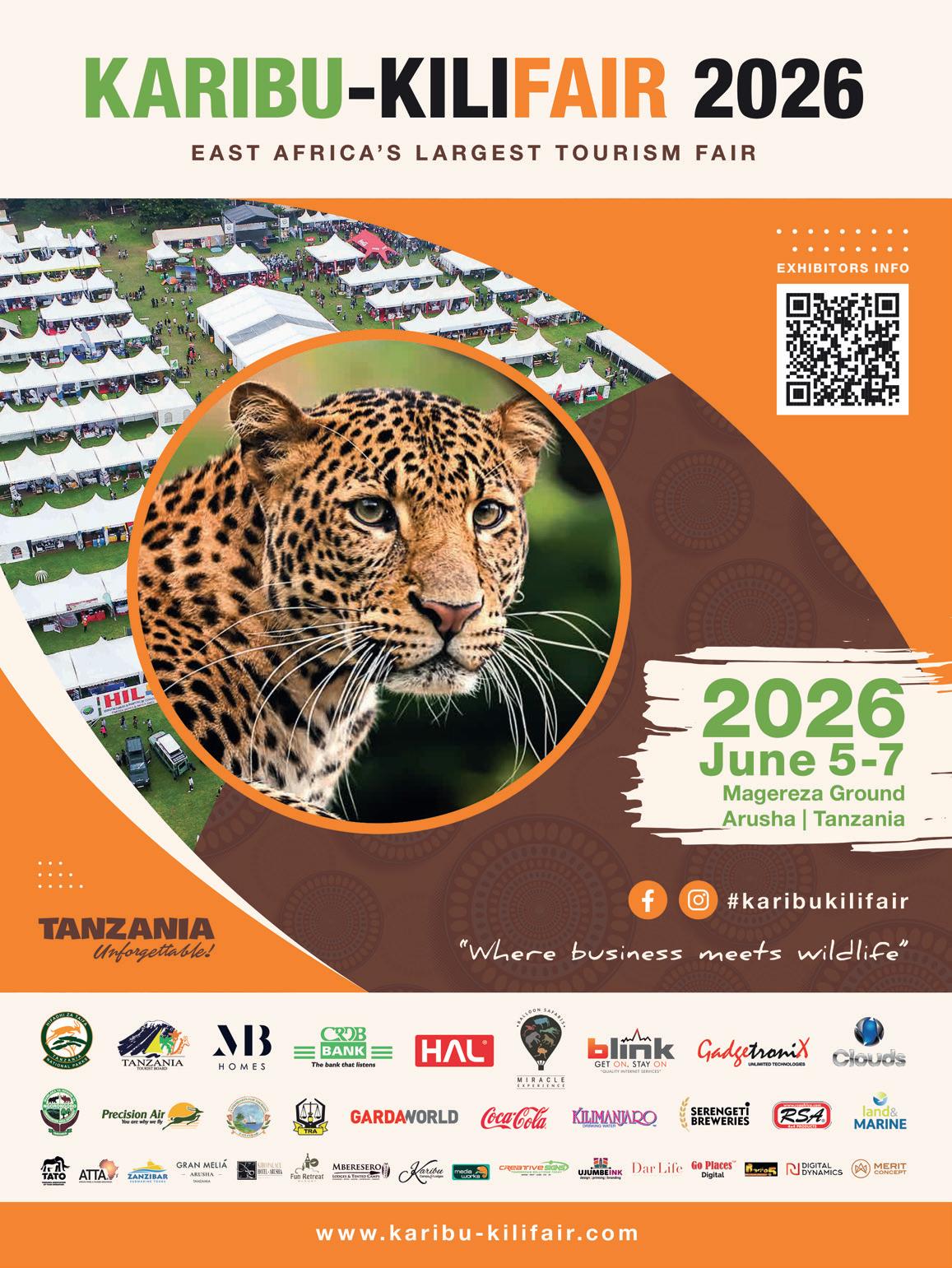
The winged wonders of Lake Manyara
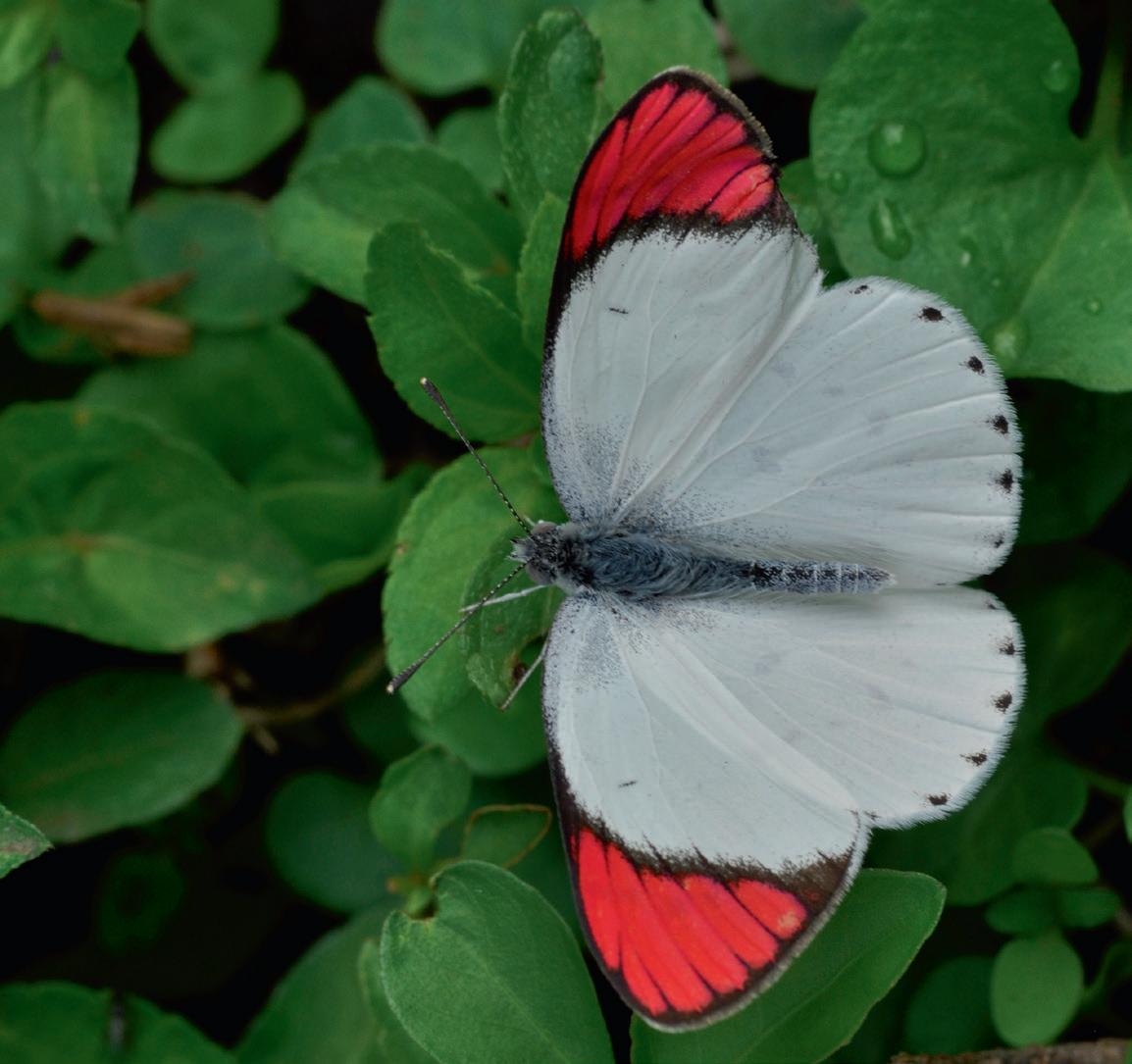
Lake Manyara is just a short drive from Precision Air destination
Arusha. John Woolmer make the journey to go in search of the national park's more than 170 species of butterfly.
In April, I visited Lake Manyara National Park with my daughter and her family. They live in Arusha, from which Lake Manyara is just a two-hour drive on the way to the Serengeti.
We saw many wild animals, especially elephants, and many birds of which the most spectacular was a very friendly red and yellow barbet which patrolled one of the picnic sites. We also
enjoyed seeing a group of pelicans swimming on the lake. For anyone wanting to see Tanzanian birds, the park provides a superb location. However, my heart was set on spotting some even smaller colourful creatures. Lake Manyara is home to 170 species of butterfly and my aim was to photograph as many of them as possible. We managed some 27 during our stay. The most beautiful

included two species of Mother of Pearl which were frequently seen in the more wooded areas. We photographed four of the charaxes species (Brutus, Kirki, Varanes and Zoolina). Zoolina has a blue coloured male, and the female is orange-brown. These are large butterflies, usually with double tails, which were often seen feeding on animal dung. This diet is thought to help the virility of the males.
Papilio dardanus(f) hippacoon Mocker
Colotis danae(m) Scarlet tip
Among the family of swallowtail butterflies to be found in the park, the Mocker Swallowtail (Papilio dardanus) was dominant. The males are large white-tailed butterflies which often feed beside roadside puddles. The ‘mocker’ name comes from the fact that this harmless butterfly mimics the appearance of poisonous butterflies for its protection. The late British physician and lepidopterist Professor Sir Cyril Clarke has always claimed that the discovery of the supergenes involved in this butterfly mimicry led to his ideas on treating the human hereditary immune disease suffered by Rhesus-positive blood-group babies born to Rhesus-negative mothers.
The white family of butterflies (Pieridae) well represented. The most spectacular were the beautiful blue vagrant (Nepheronia thalassina), the glorious coast purple tip (Colotis hetaera), and the very common scarlet tip (Colotis danae). We saw a second kind of ‘purple’ tip.
The African monarch (Danaus chrysippus) was also present. This large butterfly is protected by being poisonous to birds on account of its caterpillars feeding on the poisonous milkweed plants. The Diadem (hypolimnas misippus) females are a very
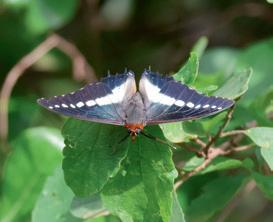
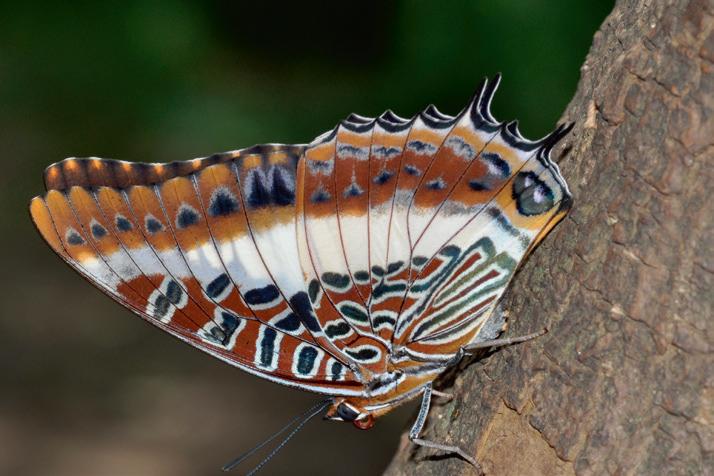
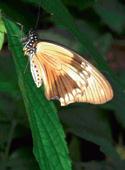
good mimic of the Monarch and thereby gain protection. The males, obviously less valuable to the survival of the species, look completely different.
We observed the painted lady (Vanessa cardui), which is found throughout the world, as well as plenty of Acraeids which are usually slow flying and relatively easy to photograph. They often pose with their wings stretched open in a way which becomes easy to recognise.
The skipper family are small butterflies which have a look and behaviour similar to moths. We were also pleased to see, among others, the two-pip policeman (Coeliades pisistrus), which gets its name from the distinctive markings
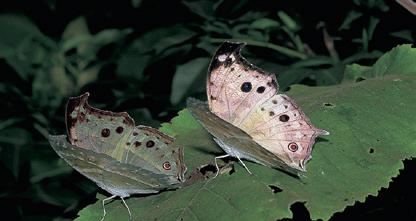

on it wings that resemble the stars ‘pips’ on a British police officer’s shoulder.
We didn’t see very many of the Blue family. Alaena ferrulineata (one of the Zulu family). Luckily, they are very docile so the few we did see sat conveniently on stems of grass waiting to be photographed.
Walking safari
We were able to walk with an armed ranger through various sections of the park. The edges of the forest areas were particularly good for seeing butterflies. Many common species, like the Soldier Commodore (Junonia terea) were present in good numbers. The early morning – from about 9am
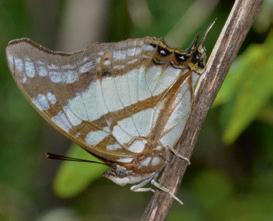

P dardanus
(f) Mocker Swallowtail
Charaxes brutus White- barred Charaxes
Charaxes Brutus White-barred
Mother of Pearl Salamis Parhassus Charaxes zoolina(m) Club-tailed
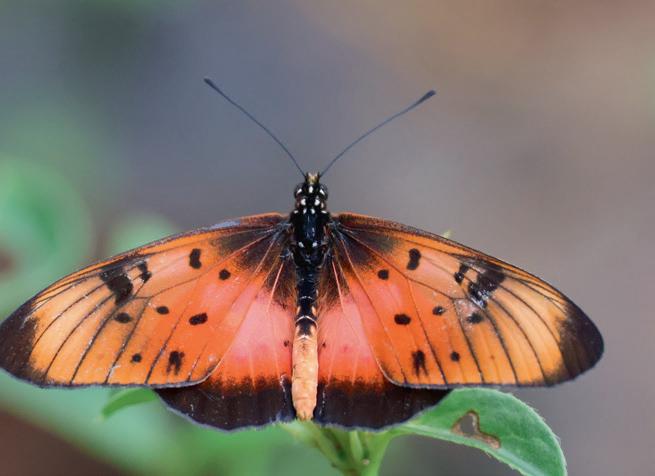
– is a particularly good viewing time. The lake, which is easily approached, provided sightings of many birds including storks, egrets, ibis, herons and pelicans. It also has plenty of hippos and crocodiles.
Lake Manyara National Park has many other attractions: troops of baboons, various monkeys, warthogs, many species of deer, giraffe, buffalo, plenty of elephants and even tree-climbing lions, which, unfortunately, we didn’t see. The baboon troops were very large; the elephants casually crossed the roads and inspected any parked vehicles
Entering the park can take time, but once you are in, the place is a delight. There is a nice
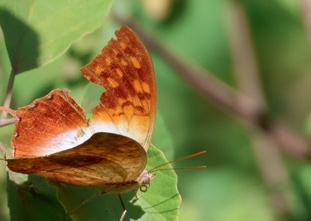
freedom in being able to explore the park’s diverse habitats. On the first day, we seemed to have the park almost to ourselves. Just also and the plentiful wildlife. Efforts to combat poaching and protect elephant habitats are beginning to yield positive results.
We would heartily recommend visiting the park and staying in the nearby well-equipped Migombani Camp which has spacious tents, a lovely swimming pool, and a decent bar and restaurant. The steep path leading from the main road to the campsite houses proved to be an excellent area for butterfly spotting. The site gives you a fine view of the nearby lake and the park entrance on its doorstep.
Photographs were taken by Ben Ray, Zaki Ray (aged 11), and Jane and John Woolmer. Most were taken in the Lake Manyara National Park with a few – of butterflies that can be seen in the park – were taken elsewhere in Tanzania.
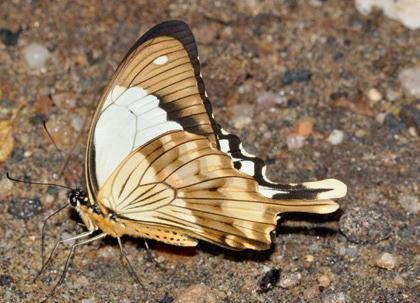
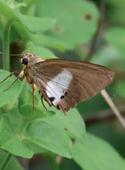
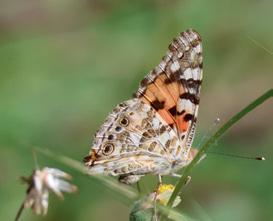

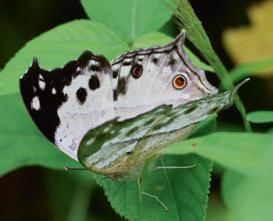
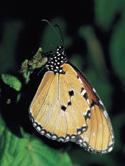
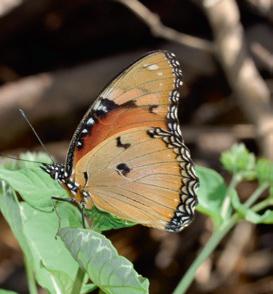
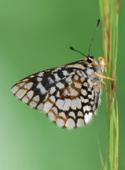
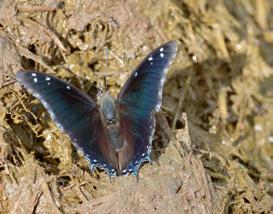
Acraea natalica Natal Acraea
Papilio dardanus Mocker Swallowtail (m)
Vanessa cardui Painted Lady
Salamis ancardii Clouded Mother of Pearl
Hypolimnas misippus (f) Diadem which mimics the Monarch
Charaxes kirki Kirk's C
Charaxes varanes Pearl Charaxes
Coeliadess pisistratus Two-pip Policeman
Colotis hetaera Coast Purple Tip
Danaus chrysippus African Monarch
Alaena ferrulineata
‘Communication
is the key to my success’
In the wake of his appointment as Chairperson of the TCAA Training Fund Committee and Vice Chairperson of the Tanzania Aviation Operators’ Association, Precision Air CEO Patrick Mwanri talks to Paa about the health of the African aviation industry and how he hopes to make a positive change in his prestigious new roles.
Q: You were recently appointed Chairperson of the TCAA Training Fund Committee and Vice Chairperson of the Tanzania Aviation Operators’ Association (TAOA). Congratulations. What impact do you hope to make in each role?
The aviation industry in Tanzania is growing which means it requires leaders who can see a way through the bottlenecks towards greater growth. My predecessors have done good things that I will build upon. I have always believed in teamwork and every member of the training fund committee and TAOA con tributes towards their goals and objectives. As the chairman of both institutions, I will ensure productive discussions in line with the planned strategies and initiatives that we have in place.
In my 20 years within the aviation industry, I have observed struggles in our daily operations. Together with other members of the committee and associa tion, I intend to identify opportunities and any potential risks facing the fund and association.


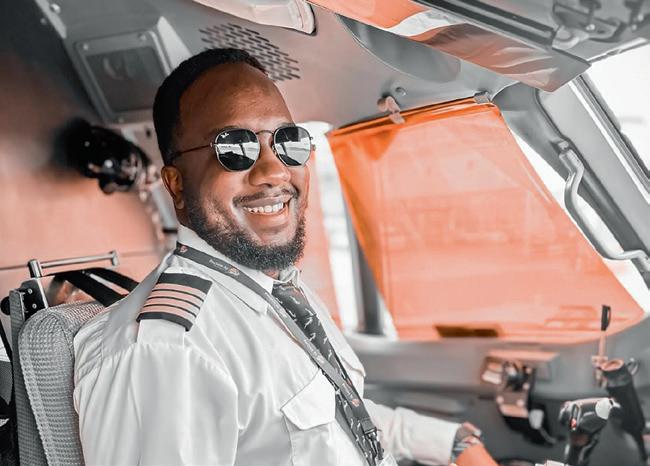
“I have always told my team not to do the work to impress their boss, but so that the ones that surround you can see the value of your work”
One of the secrets of success in any leadership position is effective communication with all stakeholders. We shall provide clarity at all times, communicating our strategy and giving our stakeholders confidence in the direction we are taking.
How do you see these two roles complementing your position as CEO of Precision Air?
As the CEO of Precision Air, I have observed and encountered various challenges in our sector that could have been resolved
externally. A quick example is the shortage of aviation personnel. This is a problem that has been blamed on insufficient financial support for training. As the new chairman of the training fund, I will prioritise securing more funds. In this and other issues in the aviation sector we shall continue to involve members in discussion and look for solutions in our sector.
Q: How proud were you to get these appointments?
I’m grateful to God for this opportunity to serve the sector. It is really motivating and energising
to see your work being recognised. It also motivates the team you are leading as they are the ones who makes things happen. So, we were happy to see the trust the Director General of TCAA, the Ministry of Transport and TAOA members had in me and Precision Air.
Q: Self-improvement seems to be a key driving force in your life as well as within Precision Air (the airline has its own TCAA-approved training centre for staff and external students). How do you see that carrying over into your role as Chairperson of the TCAA Training Fund Committee? Learning is vital for growth and facing challenges. Without it, you will be more inclined to remain the same and never figure out how to make the most of yourself and your resources. Taking on a new role opens the mind and allows you to explore new opportunities.
Q: Can you reveal your progression through the ranks at Precision Air leading to you becoming the youngest Tanzanian airline Group Managing Director and CEO?
My journey with Precision Air started in May 2004 when I joined the airline as Assistant Flight Operations Officer. Over the next 15 years I rose through the ranks. In April 2019, at the age of 44, I became Group Managing Director and CEO. I always thank God for being with me on my career growth journey. It was not
always smooth, but I believe the challenges have made me who I am today.
Throughout my career journey I was patient and focused on identifying areas for personal development. I took opportunities at the company to gain extra qualifications. I also built strong relationships with my colleagues and industry professionals that opened doors to advancement and provided valuable insights into the company and the industry. I have always told my team not to do the work to impress their boss, but so that the ones that surround you can see the value of your work. These are the ones who will support and promote you. Whatever task comes your way, do it to the best of your ability. I really like to see things being done in the right way, not only at work but also in my personal life.
Aviation is highly regulated and very tense. Every day comes with a new challenge. With a stressful role like mine, if you don’t have a stable family, you can bring all your frustration from home to work. My wife Asmaa, my late sister Lina Msanga Katema and our founder and chairman the late Michael Shirima have always been by my side offering guidance and ensuring peace of mind.
Q: The TAOA represents air operators in Tanzania, advocating for their interests and promoting the development of the aviation industry. What are your hopes for the sector in African in the coming years?
Rising levels of urbanisation, foreign investment will bring economic expansion and stimulate the demand for air travel. Tourism is being promoted in many countries in Africa, but there is still the potential for growth. We need to improve infrastructure, reduce charges and fees to airlines from various institutions, and, most of all, ensure optimum safety levels. If these issues are appropriately addressed, I see the sector growing at a rapid rate.
Q: What are the challenges of running an airline in Africa?
There are many challenges. The main ones are the availability of qualified aviation personnel, escalating high operating costs, lack of appetite for financial support, and poor infrastructure. Precision Air has been affected by the same supply chain issues that have affected airlines around the world. Escalating costs on engine overhaul and turnaround time has forced many airlines to amend their schedule on occasions due to reduced capacity.
Q: Can you tell us about the airline’s plans to increase its footprint domestically and internationally?
Our focus now is to stabilise our current operations. We still have a strong domestic operations flying to 12 destinations – Dar es Salaam, Zanzibar, Arusha, Kilimanjaro, Seronera (Serengeti), Mwanza, Mbeya, Mtwara, Bukoba, Dodoma, Kahama and Iringa. We also connect to three
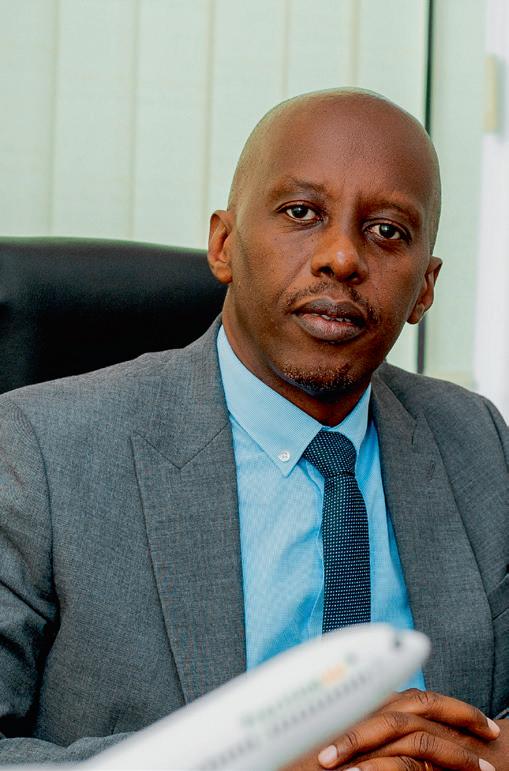
Our cabin crew are trained by our Approved Training Organisation (ATO)
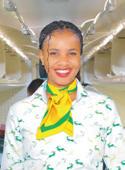
regional destinations – Hahaya and Anjouan in Comoros, and the Kenyan capital, Nairobi. Once our current plan is achieved, we hope to expand our reach in southern Africa as well as Mayotte, Réunion and Madagascar. Currently we work with more that 26 international airlines, creating further travel opportunities seamlessly from our network. We intend to increase this partnership for both local and international operators. We have also expanded the operations of our state-of-the-art maintenance hangar. As well as handling Precision’s aircraft maintenance up to C-checks (comprehensive maintenance inspections performed every 18-24 months), our Approved Maintenance Organisation (AMO) has started providing third-party maintenance

to other operators.
Our Approved Training Organisation (ATO) –that handles our in-house aviation training courses, including cabin crew training – has also extended its services to third party operators. We plan to grow this centre with more courses for pilots and flight operation officers.
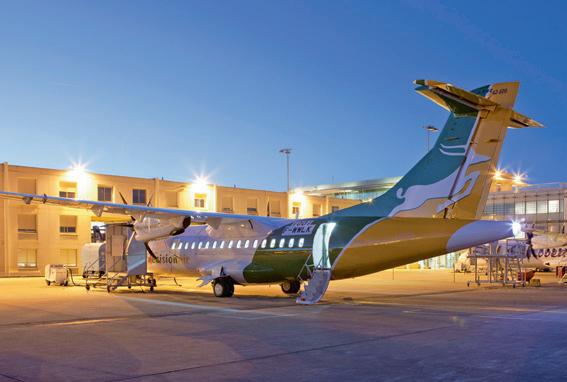
Q: How far away are we from forming a single African travel market? How important is this step?
There is still work to do, especially for those countries with struggling airlines. It is a good initiative that will open up the market but there is a risk of already well-established airlines suffocating the newer/ smaller airlines.
the challenges, we have continued to contribute to economic growth, job creation, trade (both domestic and international) and tourism.
Q: What upcoming developments at Precision Air can you share with us?
“In its 32 years in operations, Precision Air has played a major role in the country and beyond by connecting people, cultures and businesses”
Q: Precision Air is a proudly Tanzanian airline. How important is it that Precision assists economic development in the country and the broader African region by driving growth in tourism, trade, and investment through connectivity and accessibility?
In its 32 years in operations, Precision Air has played a major role in the country and beyond by connecting people, cultures and businesses. It has weathered crises and demonstrated long-term resilience in the rapidly changing environment. Despite
We launched our Dar es Salaam to Iringa route in March this year. The route will reduce travel time to Tanzania’s southern safari circuit. Currently we operate four frequencies per week to Iringa, but we aim to make it a daily flight. Our daily flights to Seronera in the Serengeti are back this season. We have also applied for direct flights from Nairobi to Arusha.
What is your favourite Precision Air destination to fly into and why?
I don’t really have a favourite route, but I was happy when we introduced the Iringa route. It is my wife’s hometown and the journeys to visit her family are much quicker.
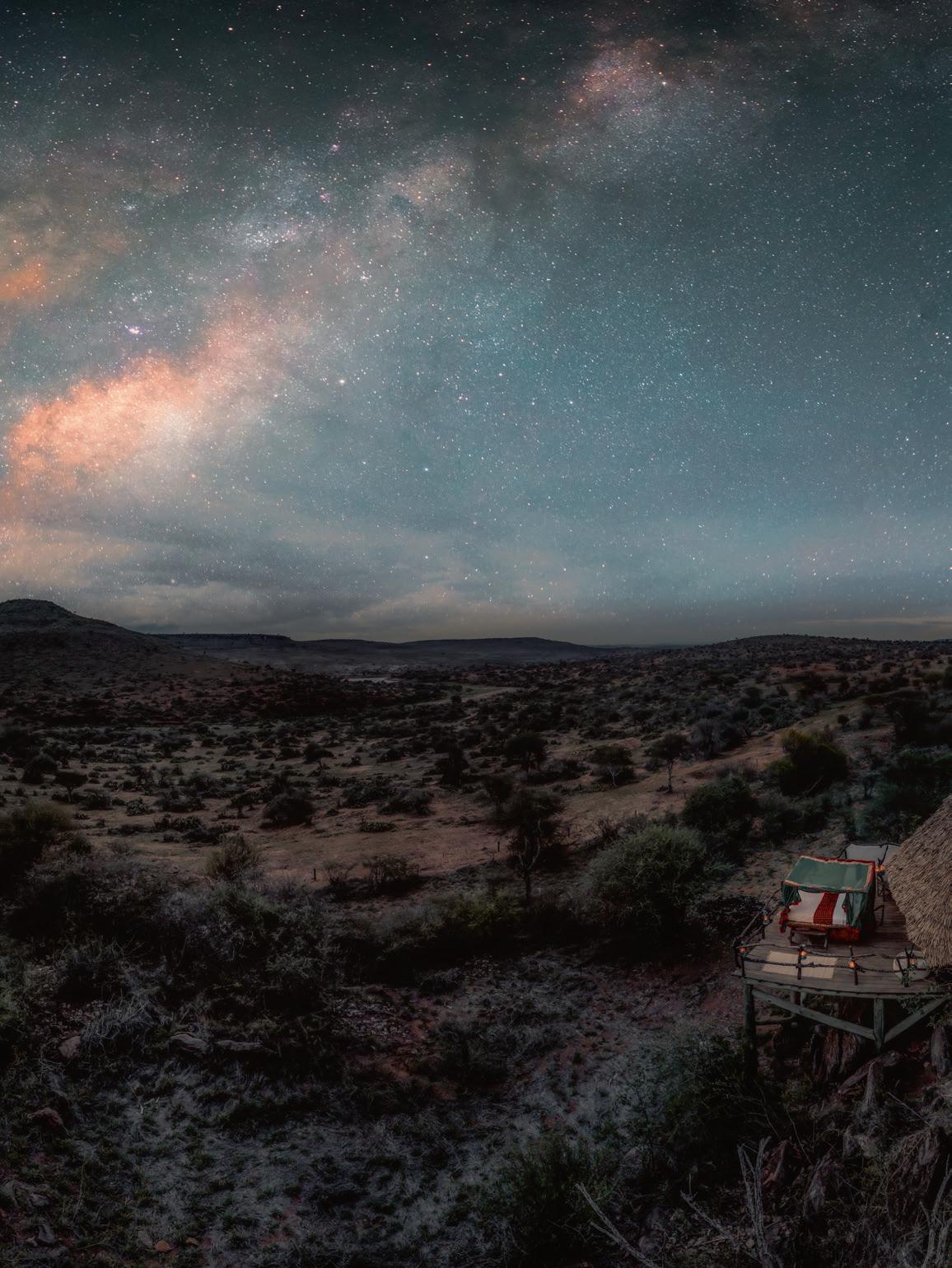
The dreamiest star beds in Kenya
Imagine drifting off to asleep under the wide, open sky of the Kenyan bush. Star beds are an exclusive experience for travellers looking for an intimate connection with nature. Here’s our guide to the accommodation options for the ultimate safari sleep-out

Basecamp Samburu
This intimate tented camp in Kalama Conservancy is Kenya’s newest star bed safari property. Officially opened in January 2025, Basecamp Samburu was designed by Norwegian architect Bull Arkitekter to include two luxury open-air star beds alongside its five safari tents.
Located in Samburu, Kalama is renowned for its clear night skies so the camp’s star beds offer an unparalleled stargazing experience. Elevated for privacy and panoramic views, the deluxe star bed includes a jacuzzi for indulgent evenings under the vast African sky while the standard star bed features a private dining area. Both options have en-suite bathrooms.
Guests at Basecamp Samburu – the latest addition to the Saruni Basecamp portfolio of 13 innovative and ethical camps and lodges0 across Kenya – have more opportunities to immerse themselves in the untamed beauty of the region. Activities include an authentic cultural experience with Samburu warriors, on-foot rhino trekking, a night-timer scorpion safari and daily game drives within either the Kalama Conservancy or Samburu National Park.
For more information, visit www.sarunibasecamp. com/our-properties/ basecamp-samburu/
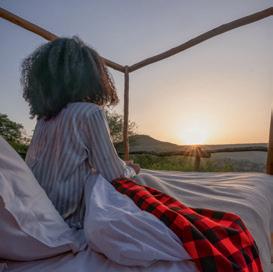
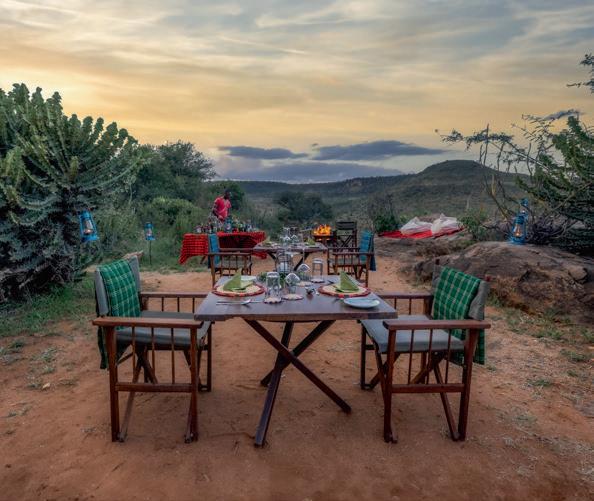
Ol Malo Lodge
Among the luxury accommodation of this cliff-top lodge in Laikipia is ‘The Treehouse’, a beautiful treetop open-air room where guests can sleep and dine under the stars. With views over the pristine plains of the wild and beautiful North Eastern Province, the rooftop hideaway is effortlessly romantic – it’s no surprise that Ol Malo has been named the world’s number one honeymoon destination. Whether you are a couple, family or a small group – the lodge can accommodate up to 10 guests – a stay here is all about experiences. Ol Malo partners with a top-notch adventure company that has a wildly disparate transport fleet – camels, horses, mountain bikes, even a helicopter – to explore every corner of the surrounding 5,000 acres of game sanctuary. Leaving Ol Malo for these wild explorations will take some will power with its all-inclusive amenities including a saltwater infinity pool, farm-to-table cuisine,
signature cocktails and morning coffee or tea served to your room. For more information, visit www.olmalo.com
Sasaab Lodge
Not strictly a star bed, but this five-star tented camp in Samburu does offer an optional night of fly camping under the stars in the Westgate Conservancy. The adventure begins with a late afternoon nature walk or game drive before arriving at the pre-pitched camp by nightfall. Here guest relax around a roaring campfire before sitting down to a starlit alfresco dinner. Then it is time to snuggle into the mosquito-netted tents and drift off to sleep to the soothing soundtrack of the bush at night. Your next day alarm will be a spectacular sunrise and the dawn chorus. For more information, visit www.thesafaricollection.com
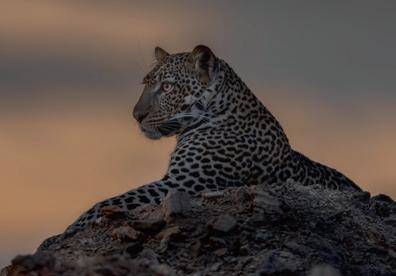
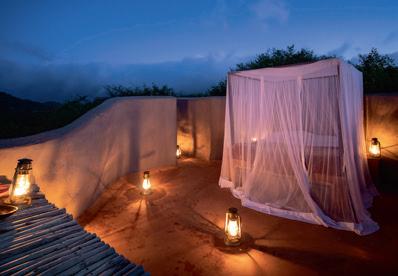
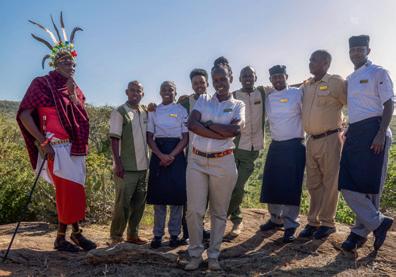
Elewana Loisaba Star Beds
The Elewana Loisaba Tented Camp has been creating bedrooms in the bush for years and there are still few who do it better. Perched on the edge of an escarpment, the camp enjoys unbroken views across the 57,000-acre Loisaba Conservancy, an outstandingly beautiful private reserve that has its own elephant migration ‘corridor’. The star beds allow guests to commune with the wildness. Handcrafted four-poster wooden beds sit on raised wooden platforms jutting out from the thatched-roof accommodation and
are rolled out each night for guests to enjoy a memorable sleep under the endless African sky. For more information, visit www.elewanacollection.com/ loisaba-tented-camp
ol Donyo Lodge
The eight deluxe suites at this camp in the Chyulu Hills of southeast Kenya come with their own swimming pools and veradahs. Each also has a king-sized star bed with mosquito netting on top of its thatched roof. The rooftop
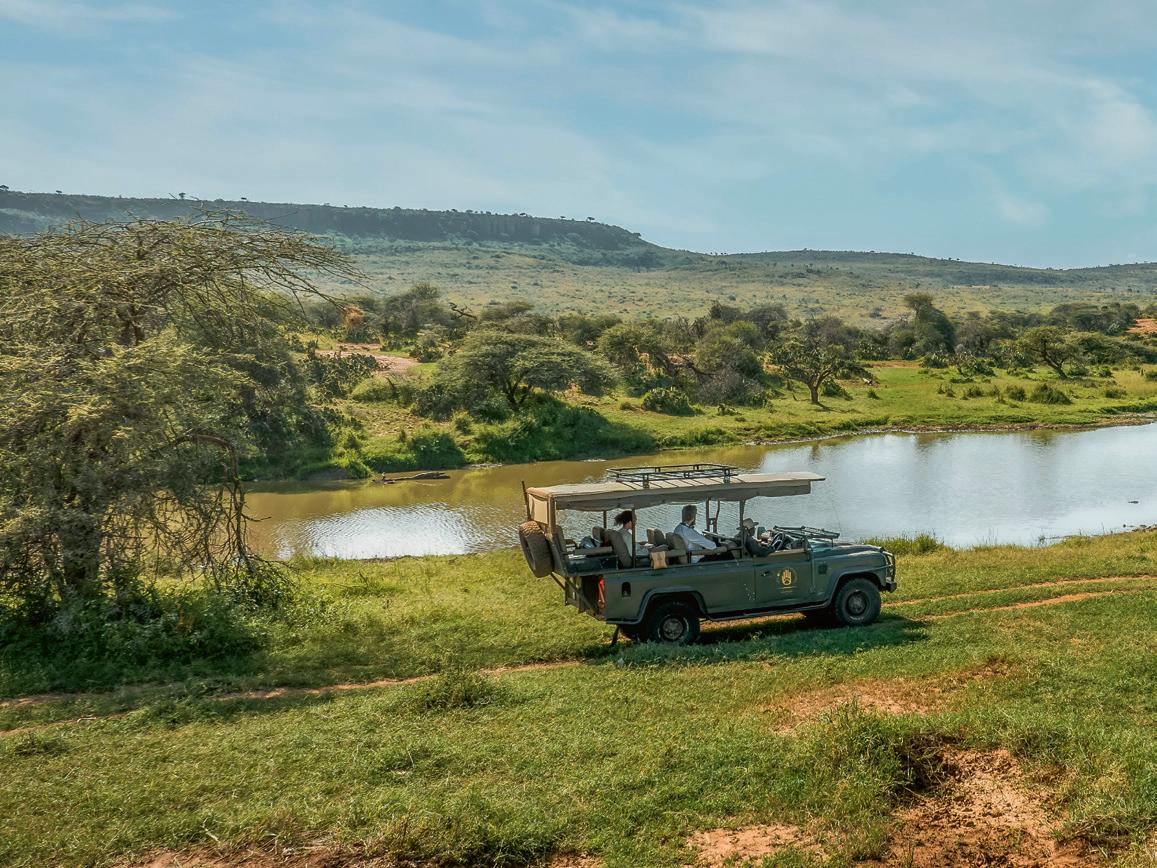
vantage points offer spectacular views of Mount Kilimanjaro during the day and a canopy of iridescent stars at night. Guests at ol Donyo Lodge can start their evenings under the stars at the camp’s new fire deck, which is a popular place for sharing safari stories. The wildlife comes to you at this camp with an on-site reservoir attracting elephants, zebras, giraffes, impalas to drink. Guests can watch unnoticed from two nearby hides.
For more information, visit www. greatplainsconservation.com/ ol-donyo-lodge-kenya-safari/
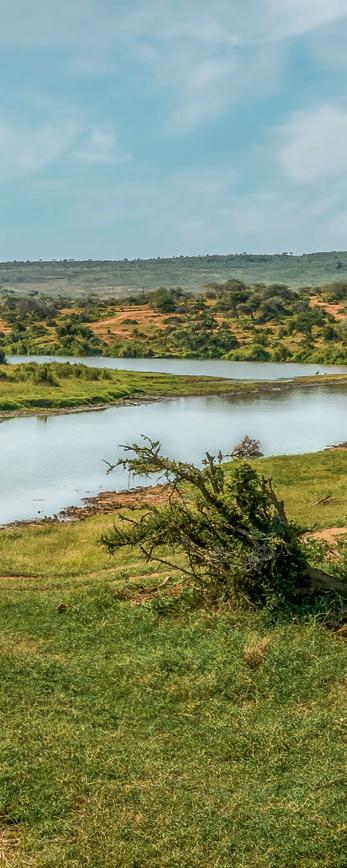
The Big Five of the African sky
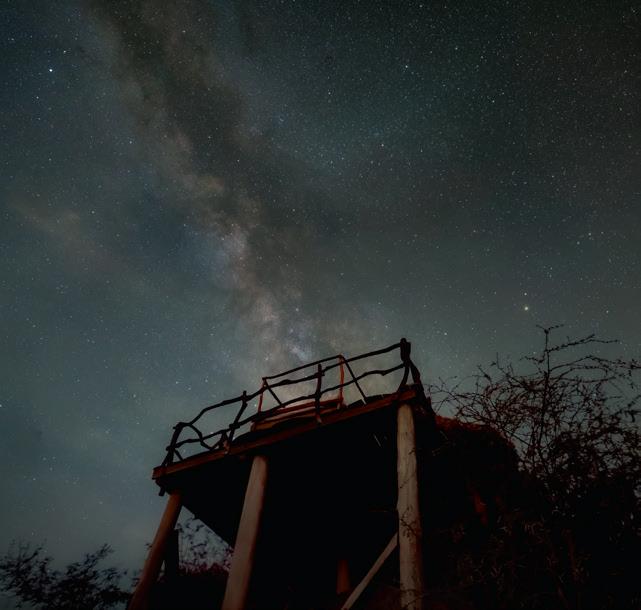
Astar bed, the dark skies of the Kenya wilderness and the naked eye should be all you need to spot these five prominent deep-sky objects visible from the Southern Hemisphere. Here’s what to look out for.
Southern Pleiades (also known as the Southern 7)
This loose group of around 70 stars is the fifth brightest cluster in the sky.
Omega Centauri
The largest and brightest globular
cluster in the Milky Way. It contains around 10 million stars.
Eta Carinae Nebula
A cloud of gas and dust located near the bright star Eta Carinae.
The Coalsack
This dark nebula – a cloud of dust that blocks out light – can be seen as a dark patch in the Milky Way.
Milky Way
The bright band of stars that spans across the sky, representing our galaxy.
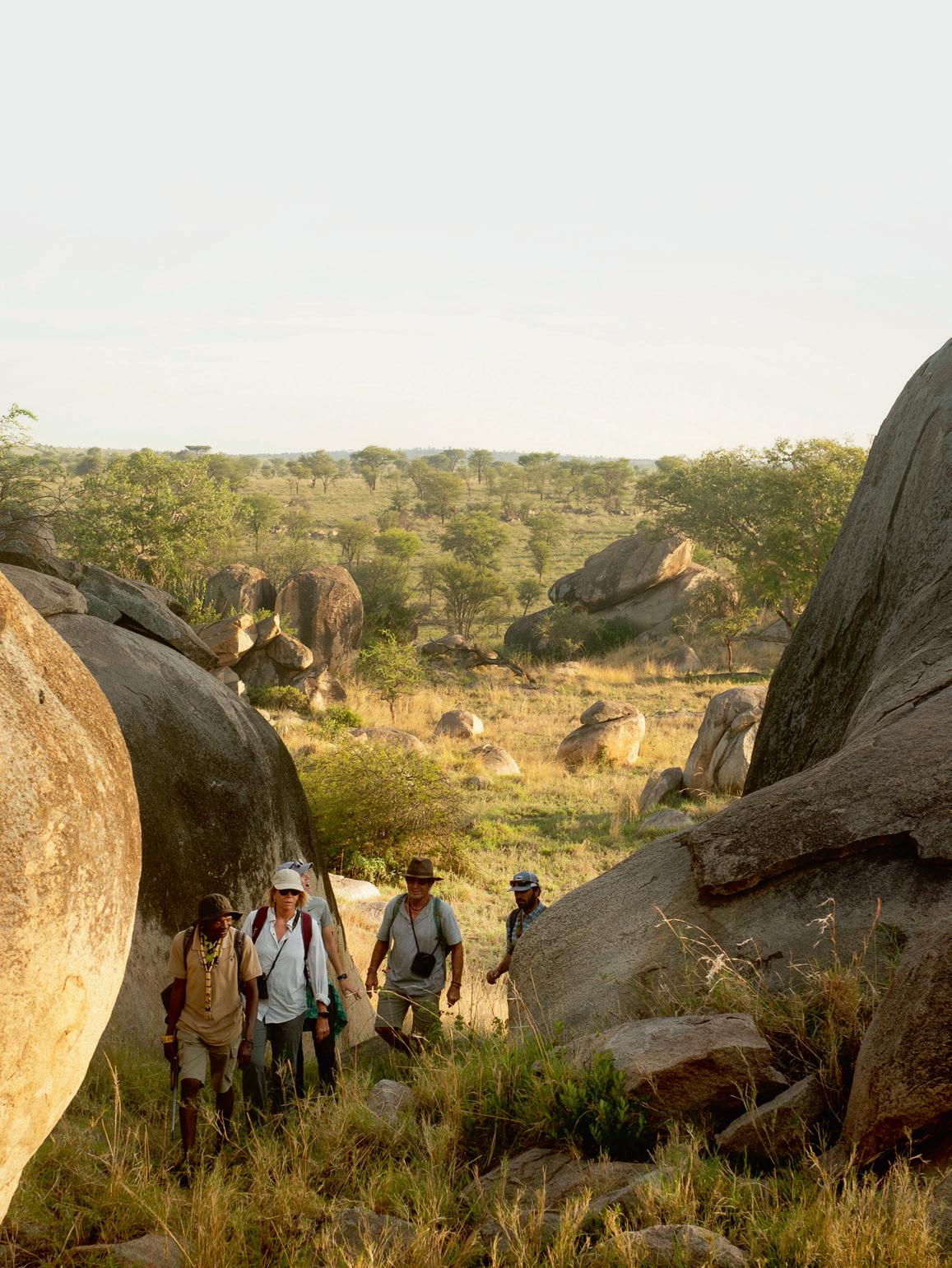
Why a walking safari reveals a different side to the Serengeti
Lucy Hills from Arusha-based tour company African Environments champions the immersive experience of exploring the Serengeti on foot.
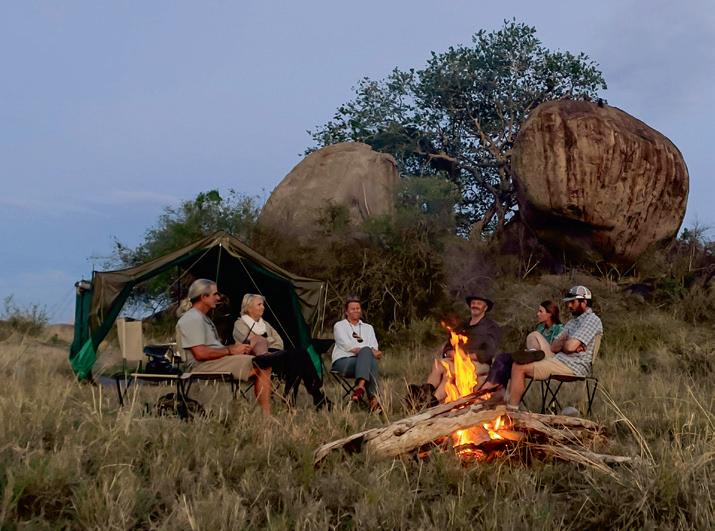
There are few things in life as humbling – or as exhilarating – as walking through the Serengeti on foot. No engines. No crowds. Just the rustle of grass, the distant call of a hornbill, and the slow realisation that you’re no longer just observing the wilderness – you’re part of it.
African Environments offer a rare experience: private walking safaris deep within the untouched corners of the Serengeti. Whether it’s a family adventure or a group of friends looking for something extraordinary, you’ll have the landscape entirely to yourselves. No other vehicles. No other people.
Just you, your expert guides, and the rhythm of the wild.
A year-round invitation to explore
While the dry season from June to October brings crisp mornings, golden light, and wildlife clustering around permanent water sources, each season offers something uniquely beautiful. The green season (November to May) transforms the plains into a lush paradise – wildflowers bloom, skies shift dramatically with passing storms, and the bush teems with young animals. Migratory birds arrive in dazzling
numbers, and the air feels freshly washed and alive. Even during the short rains, walking is both comfortable and magical, with cooler days, minimal dust, and a refreshing sense of renewal in the air.
Walk with purpose
A walking safari is not about checking boxes or rushing from sight to sight. It’s about presence. Accompanied by an armed park ranger and one of our highly experienced walking guides, you’ll learn to read the bush through sound, scent, and signs – paw prints in the sand, trampled grass, claw marks on bark. From quietly observing elephants at a distance to spotting the shimmer of a lizard sunning on a rock, each moment feels vivid and unscripted.
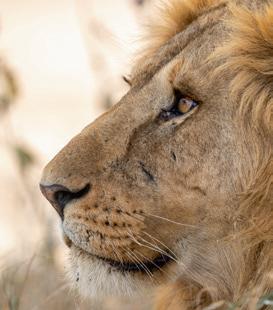
Walking creates connection – to the land, to wildlife, and to something ancient and essential within ourselves
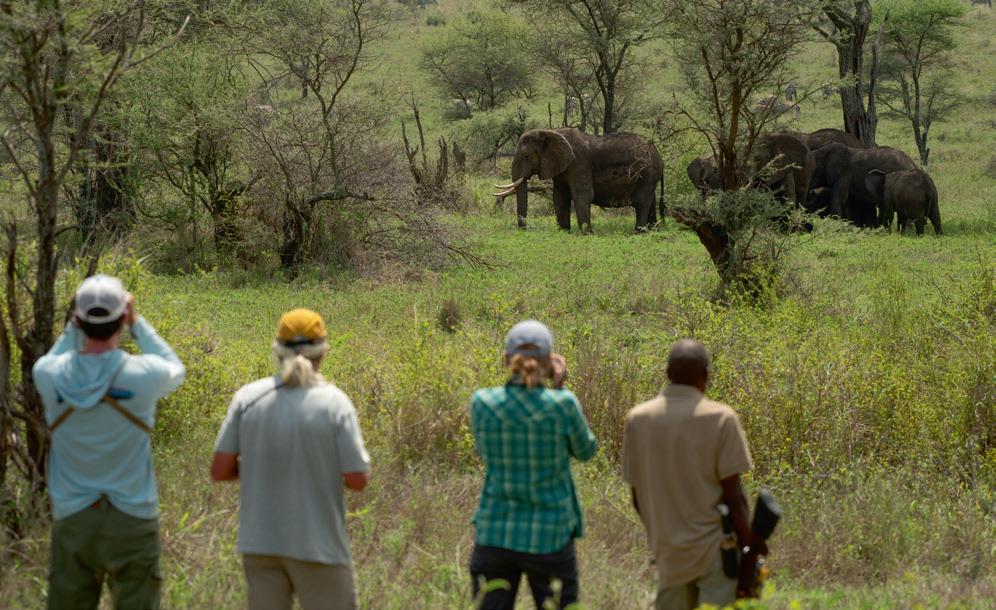
Wilderness all to yourself
Private mobile camps are set in remote, wild areas where you are the only guests for miles. Thoughtfully designed for comfort and minimal impact, these camps offer en-suite tents, hot bucket showers, and chef-prepared meals served under a canopy of stars.
Evenings are spent around the campfire with a chilled drink in hand, listening to the night come alive. There are no time limits here. No competing vehicles. Just space, stillness, and the freedom to move slowly and deeply through the landscape.
Conservation through connection
By walking instead of driving, and by operating in underutilized areas of the Serengeti, this minimises impact and helps distribute the
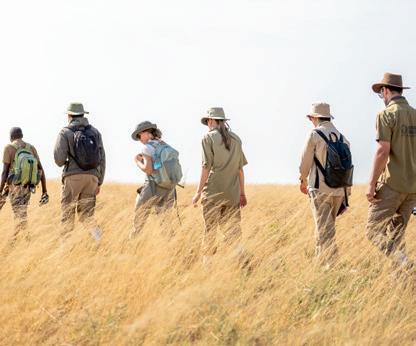
benefits of tourism more sustainably. More than that, walking creates connection – to the land, to wildlife, and to something ancient and essential within ourselves.
After following the trail of a giraffe through tall grass, or hearing a lion call in the dark from your tent, the Serengeti stops being a postcard – and becomes something deeply personal.
Time to lace up
The Serengeti is one of the most celebrated wildernesses on the planet. But to truly feel its soul, you have to walk it – step by quiet step, far from the crowds, in the company of those you know and trust.
So, if you’re ready to leave the road behind and journey into Africa’s wild heart, knowledgeable guides are ready to take you there. The Serengeti awaits – and it’s yours alone to discover.
African Environments has almost 40 years’ experience in crafting immersive Tanzanian adventures, including Kilimanjaro climbs, national park safaris and cultural visits. The company runs walking safaris in Serengeti, day hikes in the Shira Plateau area of Kilimanjaro and walks with the Maasai in the Ngorongoro Highlands. For more information contact walking@africanenvironments.com
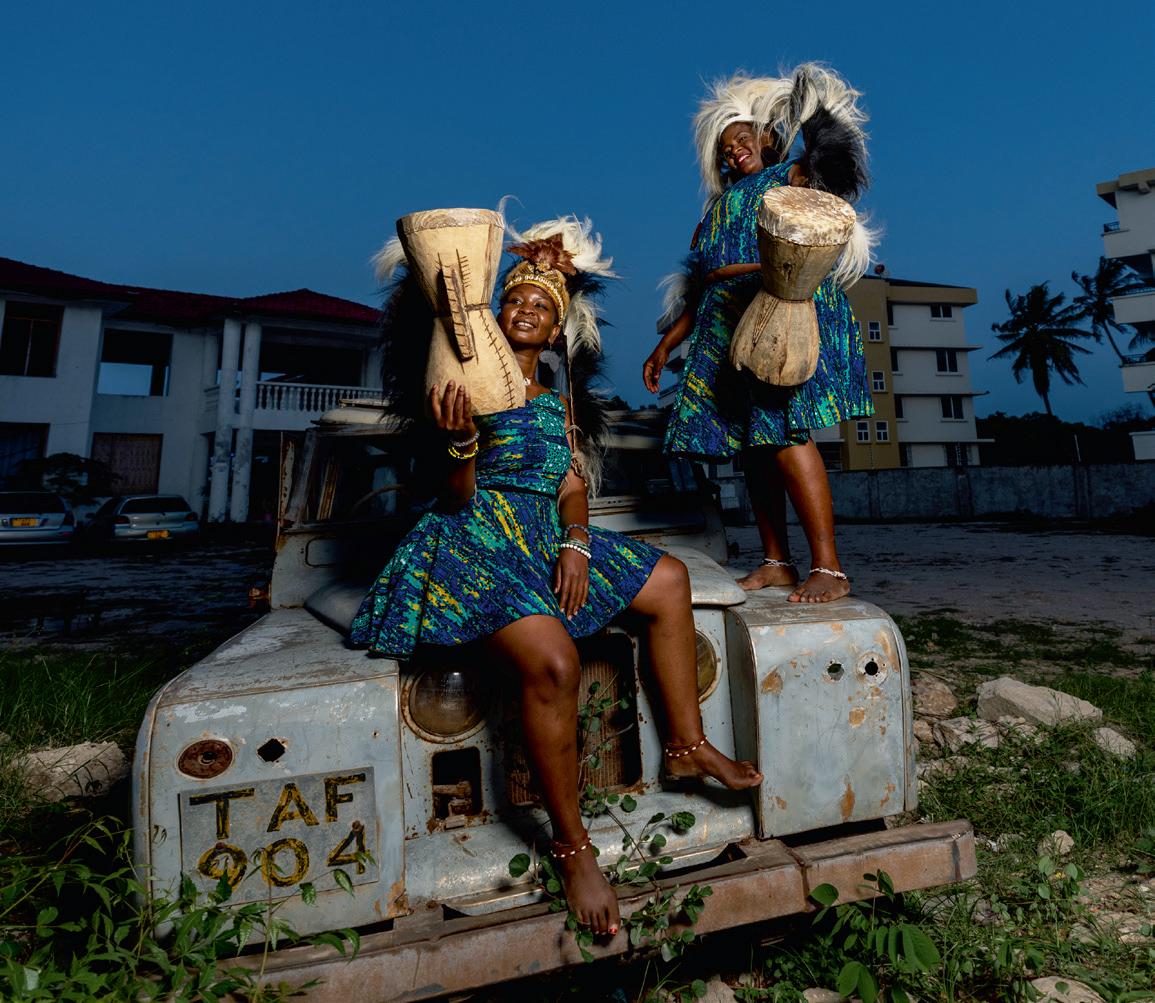
Here come the Queens
Women have long been limited to a supporting role in the music of Tanzania’s Wagogo people. However, Pendo and Leah Zawose have changed all that with an internationally successful album and tour. Mark Edwards meets the Zawose Queens.
The music of Pendo and Leah Zawose – known collectively as the Zawose Queens – represents an unprecedented break with the conventions of Tanzania’s most famous musical family.
The success of the cousins’ 2024 debut album, ‘Maisha’, followed by performances at high-profiles music festivals such
as Sauti za Busara in Zanzibar and Glastonbury in the UK, represents the first time that women of the Zawose family have grabbed the spotlight.
Pendo and Leah are, respectively the daughter and granddaughter of the late Dr Hukwe Zawose, a protégé of Tanzania’s founding president Julius Nyerere and a trailblazer for traditional Wagogo
Leah and Pendo released their debut album, ‘Maisha’, in 2024
music in Tanzania and across the world.
Hukwe had seven wives and 17 children. As patriarch of ‘Zawose village’, a multi-generational commune in coastal Bagamoyo, he encouraged his huge progeny to pursue music, but there was a strict gender divide in the skills that were passed on. The men led the polyphonic singing and were
taught to build and play traditional instruments such as the illimba thumb piano and the chizeze fourstring fiddle. The women could only aspire to be backing singers or be part of the ‘muheme’ drumming ritual.
Pendo became part of her father’s band at the age of 14, but her role remained limited. Leaha grew up in Dar es Salaam 75 km south of Bagamoyo with her musician father Ndahani Bwani Zawose (popularly known as Baba Leah) torn between sharing his skills with his daughter – who was desperate to learn – and respecting the traditions of the tribe. “My father worked as a prison warden, but he also played the chizeze and marimba. These instruments were so fascinating to me. I would sit near him just to listen to him play.
Learning in secret
“However, it was challenging. Parents and elders often said that women shouldn’t play those instruments as it was believed that menstruation could affect their tune. I would wait until my father went out, then secretly practice with his marimba, which often got me into trouble. Later, my father became my musical teacher, sharing new tunes and training me. Many family members and
'For us, singing is a source of happiness and it feels like our hearts open like a blooming rose'
neighbours discouraged me, but I refused to give up.”
Leah’s desire to perform continued to make waves when her family moved to Zawose Village after her father retired. Still a child, she crashed a performance given by the clan for a group of visiting Japanese tourists. “It turned into chaos. They told me to get off the stage, but they couldn’t get rid of me. I was reprimanded, but that moment marked the beginning of my musical journey.”
Over the coming years, Pendo and Leah honed their musical skills, often surreptitiously. After the death of Dr Hukwe in 2003, Pendo became part of The Zawose Family, a group that showcased a new generation of talent.
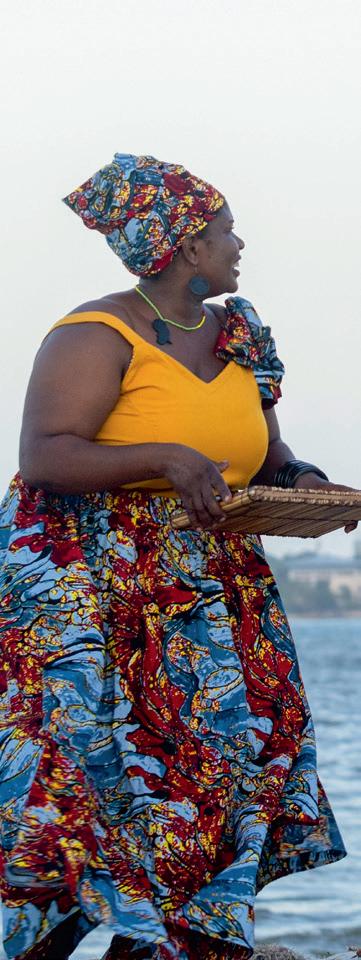
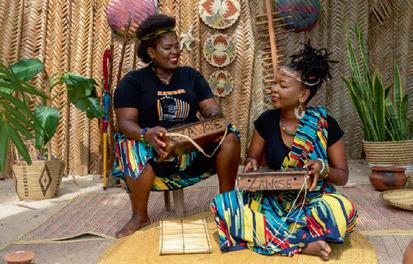
The seeds of The Zawose Queens were sown in 2019. Pendo and Leah were among the artists taking part in a songwriting workshop in Dar es Salaam organised by the British Council. Other attendees included UK-based producers Oli Barton-Wood and Tom Excell, who raised the idea of collaborating on some original material. Leah says: “They were fascinated by our music. At that time, we were only using our family’s songs, we didn’t have any of our own. We discussed recording, and we went away and wrote three original tracks, ‘Safari ya Mziki’, ‘Fahari Yetu’ and ‘Sauti ya Mamas’. They loved them.”
The next meeting was in Zanzibar where these first songs were recorded. One of them –‘Fahari Yetu’ – was captured live on the rooftop of a Zanzibari hotel and features Pendo and Leah’s hypnotic illimba playing with each note like a plump rain drop hitting the ground. Soon, the pair had written enough songs for an album with the remaining tracks recorded in Bagamoyo with Barton-Wood and Excell continuing the spontaneous vibe with recording sessions set up on a local beach.
Despite never having written music for the greater Zawose
Leah and Pendo both play the illimba (thumb piano)
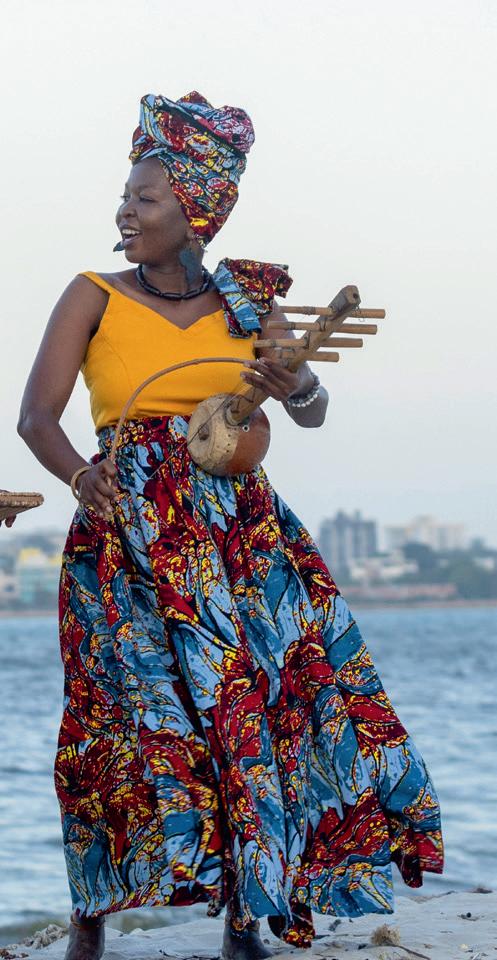
family collective, Pendo and Leah have proved prolific and talented songwriters for their debut with a credit on every track. ‘Maisha’ means ‘life’ in Kigogo and Pendo says the album’s lyrical themes embrace the everyday. “The content of our songs is inspired by life itself. We consider themes like hustling, love, family, and be inspired by our neighbours who surround us.”
The album also showcases the Queens’ playing skills. There is virtuoso illimba across the album while the song ‘Muheme’ is propelled by Pendo’s shakes
of a kayamba rattle and Leah’s pounding of ngome drums – a percussive rhythm so thrilling that all involved break into whoops of joy at its climax.
That sense of exultation is also evident when the Queens sing. Their voices – one high, one low –combine in the ‘chilumi’ polyphonic style the Wagogo are renowned for. They seem to be relishing being heard. For Pendo, to sing is to be overtaken by positive energy. “You can have many thoughts and stresses from everyday life, but when you sing, something takes over and makes you feel happy. You sing with joy. For us, singing is a source of happiness, and it feels like our hearts open like a blooming rose.”
Released on Real World Records – the label that has spread the international word on Wagogo music since Dr Hukwe’s heyday – ‘Maisha’ proved an immediate hit in Europe. For Pendo it was validation. She knew they had made “something beautiful”. The success led to high profile live shows at home in Tanzania and abroad. A particular highlight was Glastonbury in June 2024 when Pendo and Leah were very excited to meet Bob Marley’s son Julian, who was also on the bill. “For us, it was a significant step forward. We realised it was a huge opportunity for us to grow and take part in even bigger festivals, continuing to do great things.”
New music
Work on a new album is already under way. Pendo teases it will be “bigger and better” than ‘Maisha’ and will even feature some rapping. Such interweaving of traditional
and modern music forms is nothing new for the Zawose Queens. Throughout ‘Maisha’ traditional instrumentation is paired with Barton-Wood and Tom Excell’s electronic beats and loops. “Mixing traditional sounds with modern electronics creates great music,” says Leah.
Should anyone think, the pair have abandoned their roots, she adds: “Our traditional music is still there; it has simply been elevated.” For the Queens, their music is evolution, not revolution.
Celebrating tradition
Listen to ‘Maisha’ and you’ll hear multiple songs celebrating Wagogo traditions and sharing pride in its music and family connections. Two tracks on the album feature the masterful chzeze playing of Leah’s father, a former bandmate to Dr Hukwe. This is music that bridges the past and the future.
Baba Leah is not the only tribal elder that has given his blessing to the Zawose queens. Pendo says: “We haven’t received any negative energy from our family. They listen to our songs, and thought: ‘Wow, these women are capable.’ No-one has discouraged us. Our parents are really happy to see their children reaching new heights and accepting that music is in our hearts and that we love it. It’s often been the case that, during performances, everyone would speak to the men and ignore the women. But we’ve managed to make a name for ourselves.”
To stream or buy ‘Maisha’, visit www.thezawosequeens. bandcamp.com
The Zawose Queens have played major international festivals such as Glastonbury in the UK
‘This
spicy stew is a lifelong love of mine’


SChef and culinary content creator Monalisa Rwechungura shares the recipe for stewed gizzards – a favourite of hers since childhood.
tewed gizzards have always been a favourite of mine. I like to prepare the dish in what I like to call the ‘diko’ style which is full of spice and flavour. The gizzards are braised low and slow until they are
tender, then we switch it up to a stir fry and finish off with the richest most flavourful stew.
Stewed gizzards can be served with any starch of your choice but are best served with ugali or chapati.

METHOD
Prep time: 15 minutes
Cook time: 45 minutes
Serves: Four people
INGREDIENTS
• One pack gizzards cleaned and washed
• Two onions, sliced
• Three cloves of garlic, crushed
• One slice ginger, crushed
• One tablespoon tomato paste
• 64g carrots cut into thin strips
• 64g green bell pepper cut into thin strips
• 64g green beans
• 32g green onions
• 32g coriander
• One chicken cube
• One teaspoon ginger garlic paste
• One tablespoon soy sauce
• One tablespoon black bean paste (Optional)
• One tablespoon browning sauce
INSTRUCTIONS
• In a clean pan add the gizzards, chicken cube and ginger garlic paste.
• Season with salt then pour in 450ml of water, stir and boil for 20 minutes on medium heat.
• Remove the pan from the heat and transfer the gizzards and remaining juices into a clean bowl.
• Return the pan to the stove and heat a drizzle of cooking oil.
• Add in the onions and sauté until translucent.
• Add garlic and cook until fragrant.
• Stir in the ginger and cook until fragrant.
• Pour in the carrots and green beans. Cook until they begin to wilt.
• Add the green bell peppers and stir.
• Reintroduce the gizzards and their juices and cook until all the liquid evaporates.
• Stir in the tomato paste.
• Pour in the soy sauce and black bean paste and stir.
• Sprinkle in the green onions and cilantro.
• Stir in 120ml of water, cover the pan and cook for two minutes.
• Add the browning and cook for the final three minutes.
• Serve and garnish with coriander leaves.
• De-glaze the pan with 120ml of water, stir while scraping the bottom of the pan to release the bits that are stuck.
Precision Air at Kilifair
Precision Air was proud to be part of Kilifair 2025 in Arusha. We were among the sponsors of East Africa’s largest tourism expo, which this year marked its 10th anniversary. Precision welcomed many wonderful visitors to its stand and buyers’ lounge. They were greeted by a team that included our CEO Patrick Mwanri, Head of Commercial & Ground Handling Lilian Massawe, and Marketing & Corporate Affairs Manager Hilary Mremi. We extend our deepest gratitude to the organisers and all participants who contributed to the success of this exceptional event. Here are some picture highlights.
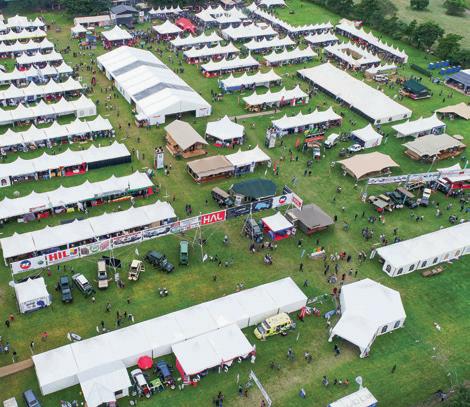
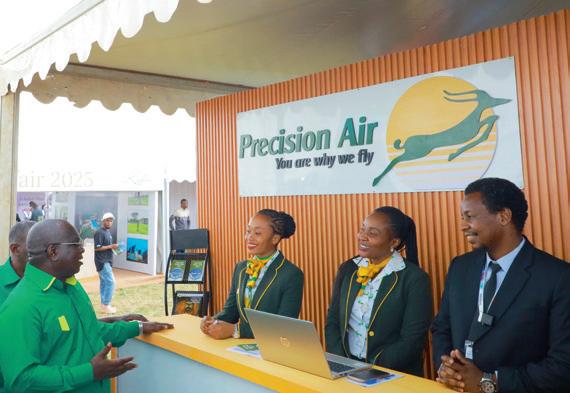
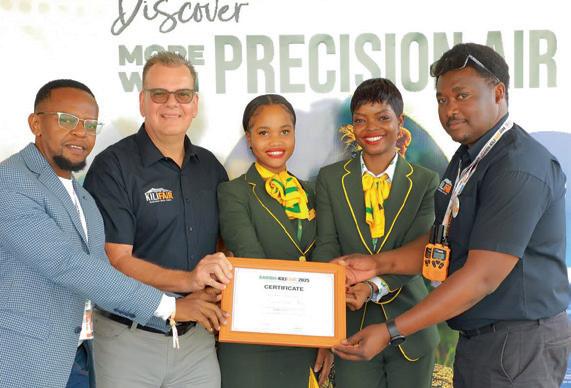


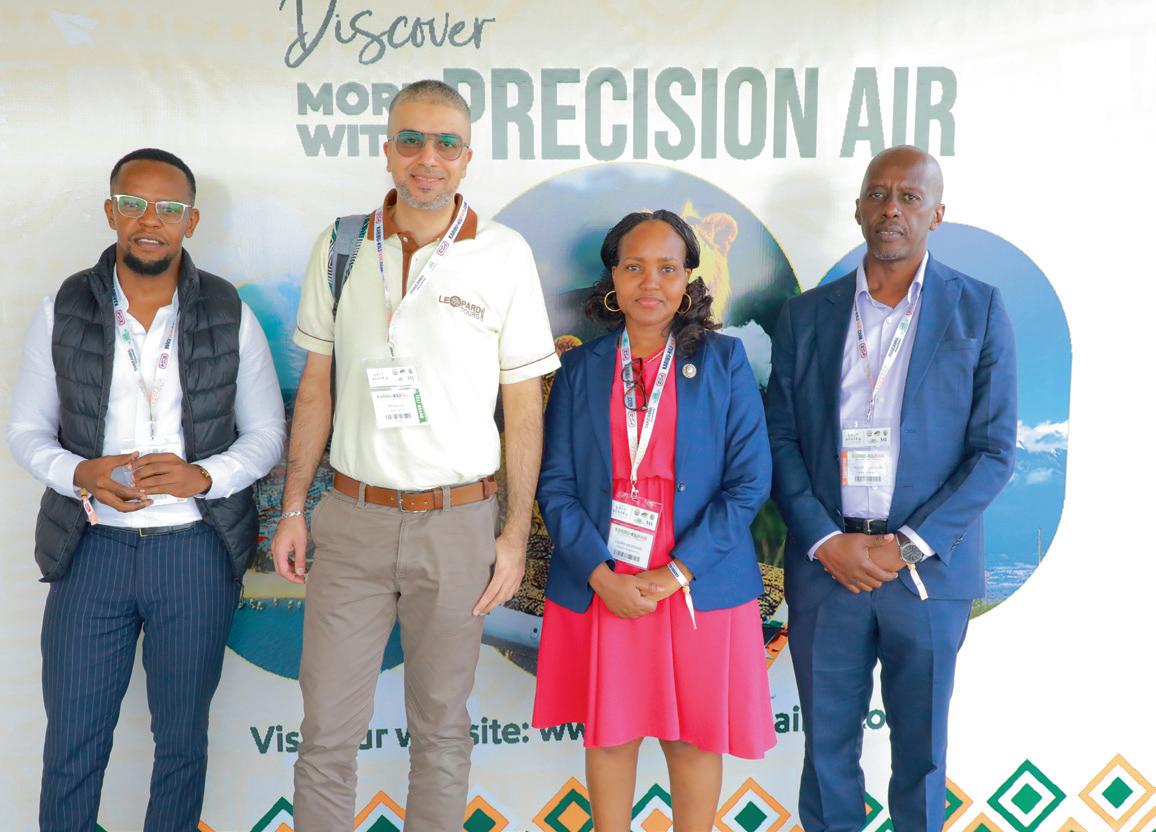

Films to look out for at this year’s event
From a Tanzanian rom-com to a documentary about a Kenyan widow battling to reclaim her land, here’s just some of the fresh releases to look out for at this year’s Zanzibar International Film Festival.
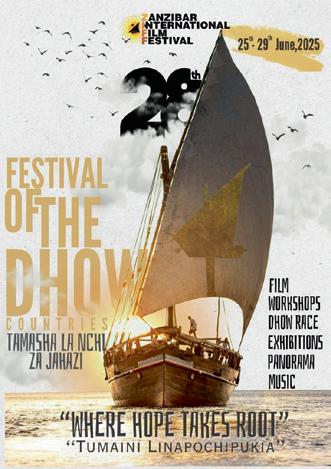

The Zanzibar International Film Festival (ZIFF), now in its 28th year, has become one of the largest cultural events in East Africa. This year’s event runs from June 25-29 with 70 films from around the world being screened.
The central hub for activities is the Old Fort in Stone Town. The historic venue hosts the main screenings along with film markets and workshops, but events also extend across the islands of Unguja
and Pemba with more screenings, music performances and even a dhow race.
While ZIFF attracts filmmakers and screen stars from far and wide, the inclusive event seeks to involve locals young and old. With no permanent cinemas on the archipelago, the festival is the only chance for many Zanzibaris to experience the magic of the big screen. Local schoolchildren are given free access to the Stone Town screenings and pop-up cinemas are set up in remote regions of
the island for more free film-watching.
There is a buzz across the islands during the five-day festival and visiting world cinema enthusiasts are sure to enjoy a memorable experience for world cinema enthusiasts.
ZIFF is also known as the Festival of the Dhow Countries as it celebrates the diverse cultural connections formed by the Swahili coast’s historic Indian Ocean trade links with the Middle East, India, and Southeast Asia. For centuries,
dhows – handmade wooden sailing ships harnessing the seasonal monsoon winds – facilitated the transport of goods, people, and ideas across the region. ZIFF showcases submitted films from these countries as well as across Africa and the global diaspora.
3,000 films
This year 70 films and TV programmes are in competition, narrowed down from more than 3,000 submissions. Each successful entrant represents in its own way the theme of this year’s festival, which is ‘Where Hope Takes Root’.
Festival director Hatibu Madudu is very excited about this year’s event. “Our films this year reflect a new focus the festival. We want to screen new and fresh films that have their première in Zanzibar.
“This year’s theme ‘Where Hope Takes Root’ encapsulates the essence of Zanzibar, ZIFF and Africa, emphasising our shared commitment nurturing creativity and innovation across the continent.
“We look forward to see all of you in Zanzibar.”
As a taster of the cinematic treasures in store we have selected five films we think will rock this year’s ZIFF.
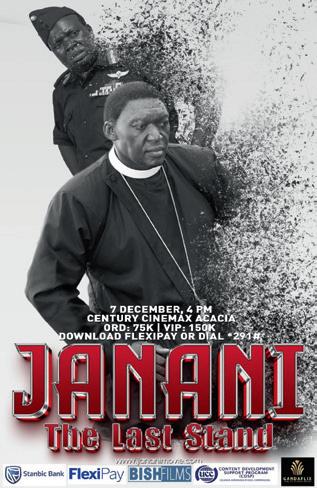
Janani ‘The Last Stand’
DIRECTOR: MATT BISH
This inspiring Ugandan film immortalises the courageous stand of Archbishop Janani Luwum against the oppressive regime of dictator Idi Amin. Luwum was the archbishop of the Church of Uganda from 1974 to 1977 and one of the most influential leaders of the modern church in Africa. He stood for justice and freedom for the people despite knowing it would cost him his life. His legacy lives on as a symbol of resistance and moral integrity –there is a public holiday in his honour each year in Uganda –and this film is a fitting testament to this modern martyr.

The Christmas Run
DIRECTOR: ENOS OLIK
This Tanzanian festive romantic comedy got a cinematic release across East Africa late last year while also being picked up by Netflix. It marks another success for Tanzanian production company Black Unicorn – the team behind 2021’s Dar-set drama ‘Binti’.
The Christmas Run channels the new dating trend of running clubs with lead character Nuru joining one to get over a bad break-up. Her first meeting with fellow reluctant runner Alex is frosty, but when the pair team up for a charity Christmas marathon a bond begins to bloom.

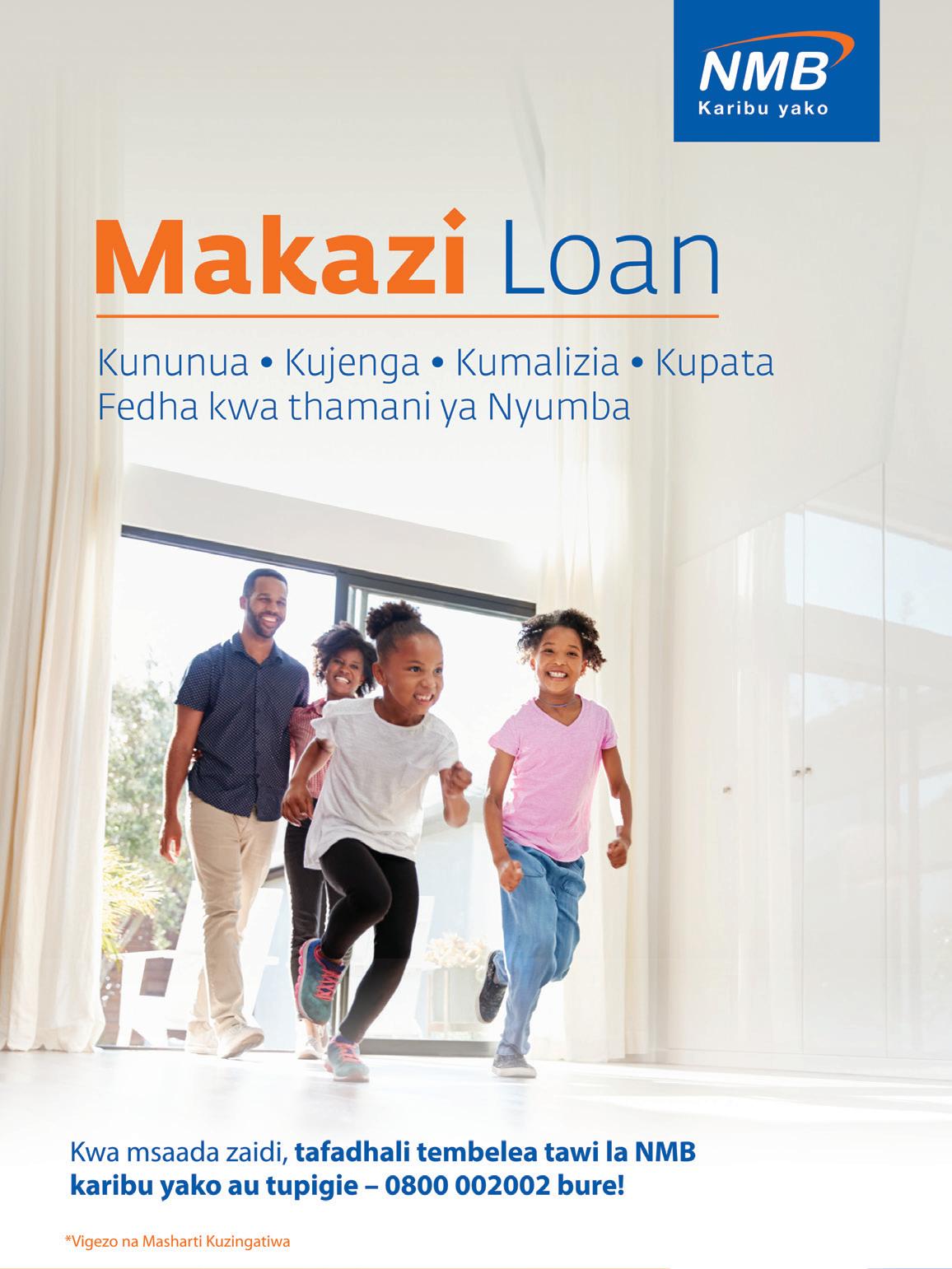

Rangashoor
DIRECTOR: PRATAP ROUT
The ‘Bagha Nacha’ or ‘Tiger Dance’ is a traditional folk dance performed in Odisha in eastern India. The dancers dress in tiger costumes and are primarily male. However, this colourful, magical story of courage and resistance focuses on Chitra, a 20-year-old woman from Olab village, in Odisha, who is the only child of a Baga Nacha dancer and carries on the family tradition. Her dancing is frowned upon by some of the village elders who consider it disrespectful of tradition, but there are wider problems for the community with outside threats to their forest home. A must-see.
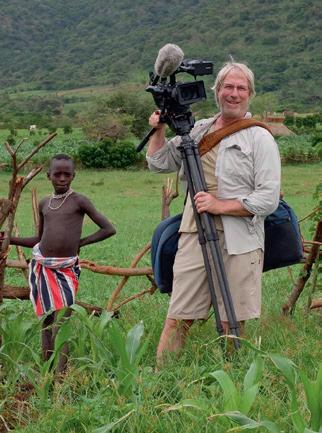
A Duty to Remember
DIRECTOR: CHARLES DOMINGUE
Canadian singer Patrick Norman didn’t know it at the time, but in 1994, at the height of the Genocide Against the Tutsi, his song ‘Quand on est en amour’ captured the hearts of the Rwandan people. The song – Norman also released an English version which he called ‘Only Love Sets You Free’ – conveys the importance of being open to love even in difficult times. The song’s lyrics crossed borders and served as a balm for Tutsi victims during the worst moments of their lives. Thirty years later, accompanied by Canadian filmmaker Domingue, Norman visited Rwanda to meet locals who still remember how his song was an emblem of hope in dark times. An unforgettable film about the healing power of song.

Jivu
DIRECTOR: MUSTAPHA MACHUPA
The television drama series exposes the rivalries and relationships within a wealthy Dar es Salaam family. Everyone seems to be hiding secrets from the bitter matriarch through the son who returns from studies abroad with a woman he intends to marry prospective to the stressed-out housemaids. A complex drama with plenty of twists and turns.

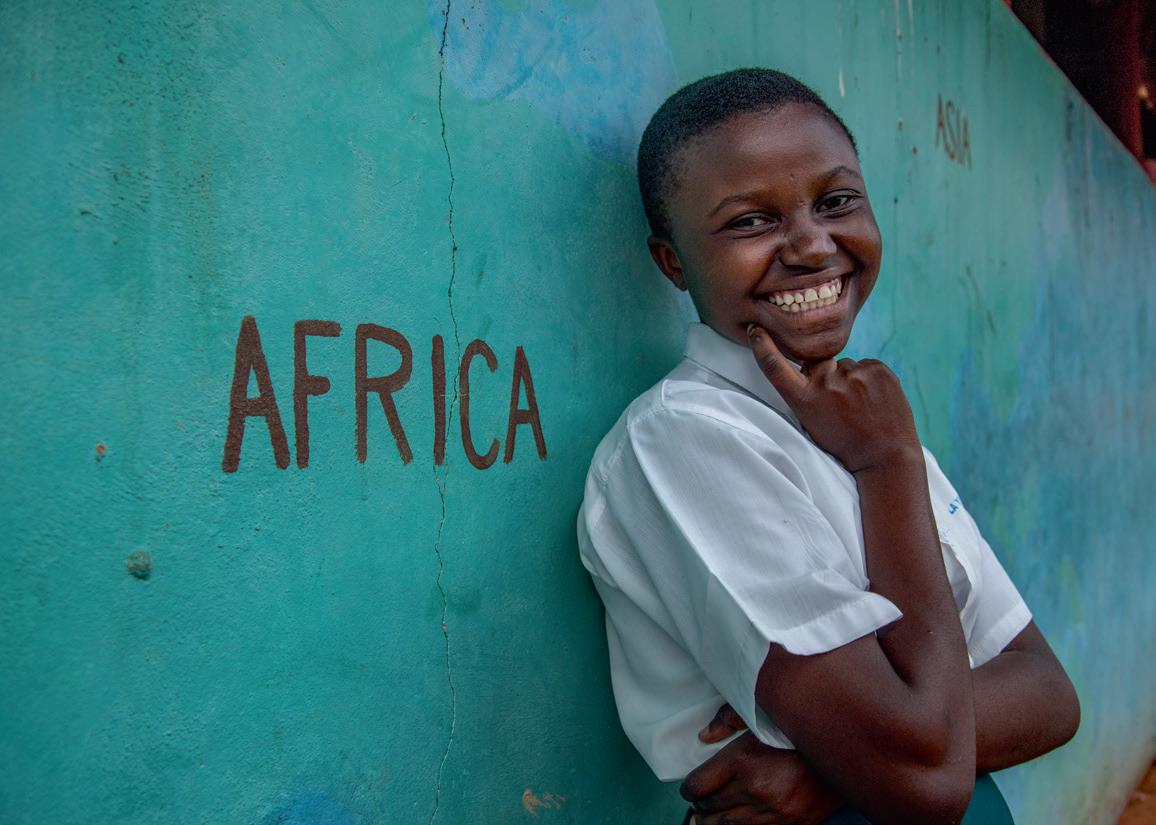
How SEGA in Morogoro transforms girls into leaders More than a school
Nestled at the base of the stunning Uluguru Mountains in Morogoro, lies a place that is quietly sparking a revolution – one educated girl at a time. The Secondary Education for Girls’ Advancement (SEGA) is not just a school, it’s a launching pad for possibility, a sanctuary for resilience, and a model for how to create lasting change.
Founded in 2008 through a partnership between Tanzanian visionaries and the U.S.-based non-profit Nurturing Minds, SEGA was created to address the urgent need for quality education, life
skills, and entrepreneurship training for at-risk girls in Tanzania. The NGO was founded on the belief that every girl deserves the chance to learn, lead, and thrive—no matter her financial background. Today, SEGA serves more than 280 students from over 25 communities across Tanzania – empowering girls to rise, lead, and give back, while rewriting what’s possible for girls across the country.
Why educating girls changes everything
Globally, educating girls is one of the most effective ways to combat
poverty, reduce inequality, and improve health and economic outcomes for entire societies. And yet, millions of girls continue to face significant barriers to this
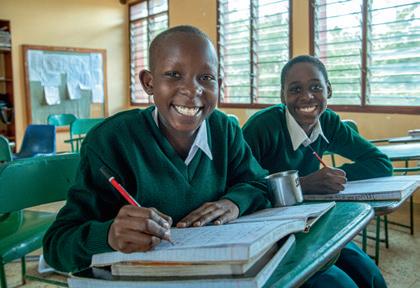
SEGA students
basic right. In families with limited financial means, education is often viewed as a luxury—and when choices must be made, boys are typically prioritised because they’re expected to contribute economically. Girls are too often left behind, regardless of their academic promise or desire to learn. SEGA is changing that.
On its solar-powered, environmentally sustainable campus, SEGA ensures that girls not only receive a cost free high-quality academic education but also gain the tools they need to thrive in life and leadership. With 99 per cent of graduates pursuing higher education, and 70 per cent attending university – compared to just 3 per cent nationally – SEGA offers a proven model for success.
As SEGA students go on to become teachers, entrepreneurs, engineers, and advocates, they are transforming their families, communities, and country in the process.
Education that goes beyond the classroom
SEGA operates four complementary programmes.
The SEGA Girls’ School:
A private secondary girls’ boarding school, which follows the Tanzanian curriculum and adds practical, relevant skills training through its Entrepreneurship, Education for Life, Career Development and Environmental Stewardship programmes.
The Modern Girl Community Outreach Program:
Training recent SEGA graduates
Join the Movement: Invest in Tanzania’s future
Learn more
Discover the impact of educating and empowering women and girls – and how it’s shaping Tanzania’s future – at www.nurturingmindsinafrica.org.
Visit and stay at SEGA
Experience SEGA firsthand with a visit to the SEGA Girls’ School. Guests stay on campus, engage with students and staff, and explore Tanzania’s beauty through guided off-campus adventures. To learn more or book your visit, email: info@nurturingmindsinafrica.org.
Volunteer
Volunteering at SEGA is a great way to have a positive impact on the lives of every SEGA student. Volunteers can take part in our annual English Fluency Programme (October 9 to 25, 2025) to teach English at the school or our STEM Adventures at SEGA Programme (exact dates to be confirmed) to promote STEM education.
and members from the local community to become mentors and teach life skills, sexual reproductive health and rights, financial literacy, and small business development to girls and women aged 10 to 25 in their communities.
The Continuing Education Scholarship Programme: Providing scholarships to all SEGA Girls’ School graduates who qualify, enabling them to pursue A-Levels (Advanced High School degrees), university, certificates and diplomas, vocational training, and internships.

Take part in Summit for SEGA
Visit the campus and climb Mount Kilimanjaro while raising funds to support continuing education scholarship for SEGA graduates. Next year’s event takes place from July 13 to 26. Contact info@nurturingmindsinafrica.org to find out more.
Support a Student Scholarship
For just US$3 a day you can fund a scholarship that gives a girl the education she deserves. You’ll see the direct impact of your support through updates from your sponsored student, while also engaging in a meaningful cultural exchange that helps her strengthen her English skills. Become a student scholarship supporter today by visiting www.nurturingmindsinafrica.org
The SEGA Graduate Business Development Programme:
Offering small business development skills training and microloans are provided to SEGA Girls’ School graduates and graduates of the Modern Girl Community Outreach Programme to grow their businesses.

Together, these programmes form a powerful ecosystem that not only uplifts individual girls but also plants the seeds for systemic change across Tanzania.
Transforming lives


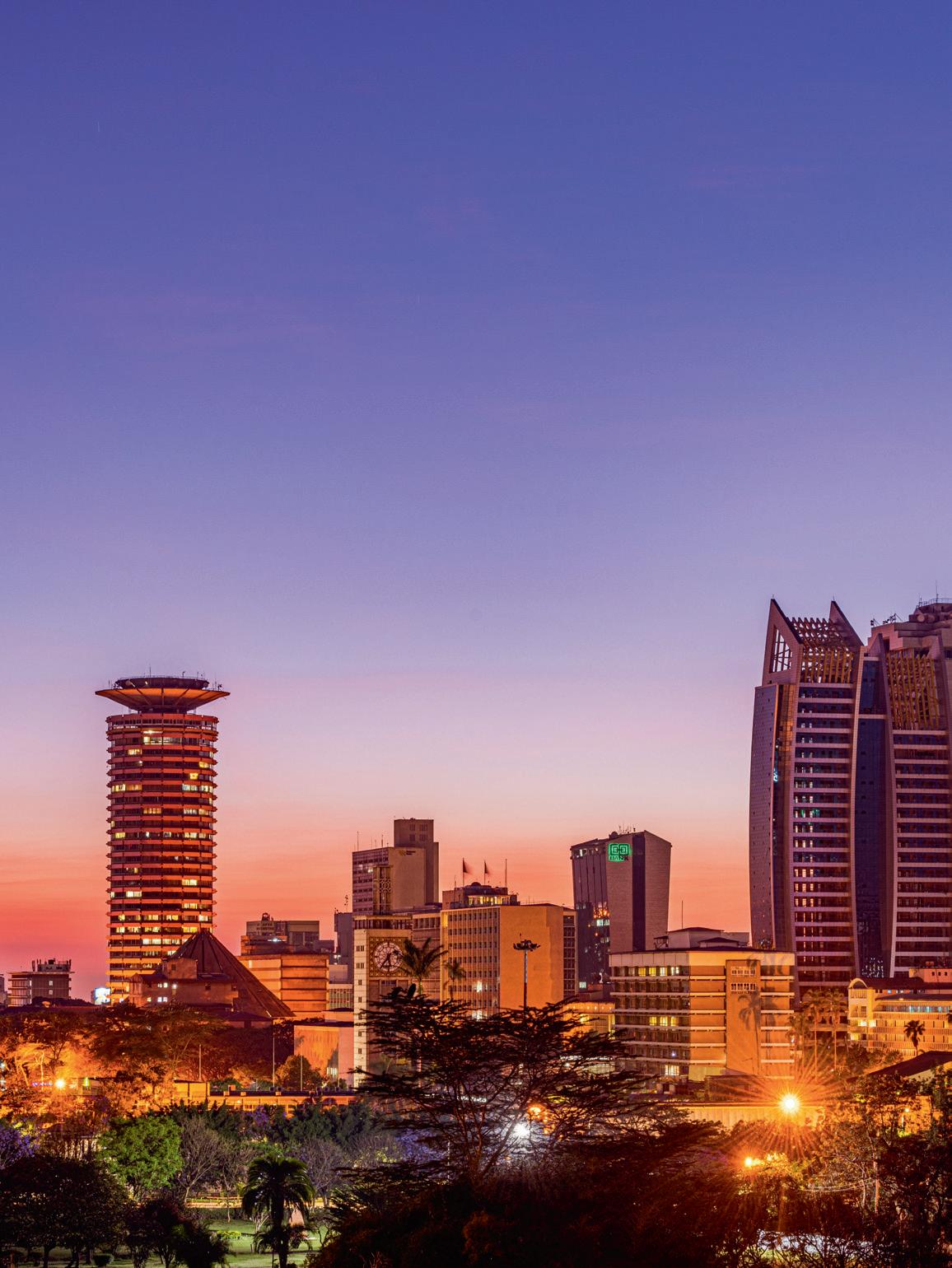

Travel influencer Adam Maina reveals the Nairobi he knows
With the launch of our flights to Nairobi we thought we’d get the inside story on the vibrant Kenyan capital from someone who knows it well. Adam Maina is a purpose-driven travel influencer and lifestyle creator who’s redefining African luxury travel and lifestyle content. He speaks to Paa magazine about what makes his hometown so special.
Q: Which part of Nairobi do you live in? Why did you choose there?
I live in the lush, leafy suburb of Rosslyn. It’s where Nairobi exhales. Think birdsong in the morning, winding roads, and just enough privacy to dream loud. It gives me space to create and recharge.
Q: Where is your favourite place to start the day in Nairobi? Java House. Always Java. There’s something beautifully Kenyan about walking into a branch of this local coffee chain. It is like a daily reset with the city’s heartbeat. Their coffee? Deep, rich, and familiar. And don’t get me started on that croissant with extra butter. It’s not just breakfast, it’s therapy.
Q: As a travel influencer, what are some of the Nairobi attractions you have recently recommended to your followers? So, everyone knows Nairobi National Park is the go-to answer, but the twist now? Night game drives. Some city hotels are offering them, and it is pure magic. Imagine lions under moonlight with the skyline behind you. Also, Ngong Hills in the evening is the ultimate mix of breeze, views, and that dramatic sky that makes you believe again.
Q: Which shops do you rely on in the city?
I live on Greenspoon. Kenya’s online gem. Their fresh juices are elite, their delivery smooth, and the quality? Chef’s kiss. For fashion, I go bold with Kitu Kali because Kenyan creativity deserves the runway. Sarit Centre is my
everything mall. Grocery run, spa moment, quick sushi fix. It’s a city within the city.
Q: Who is your Nairobi icon?
Larry Madowo [Kenyan reporter, broadcaster, writer and news anchor] No question. He’s brave, grounded, and refreshingly bold. He embodies the modern Kenyan. Sharp, global, and unapologetically local. Larry isn’t just reporting the story, he is the story of where Kenya is heading.
Q: How would you spend the perfect lazy Sunday in the city?
Start with a chill breakfast at Paparotti. Those brunches are sinful in the best way. Then take a scenic drive to Brackenhurst in Tigoni. That place slows time. I’d do a peaceful walk, queue up my favourite playlist, and end the day with some good comfort food like their wood-fired pizza.
Q: How would you describe the character of a typical Nairobi resident?
Nairobians are a cocktail of hustle, humour, and style. We know how to laugh through chaos, dress like we own stock in Zara, and still haggle for parking change. Nairobians survive,
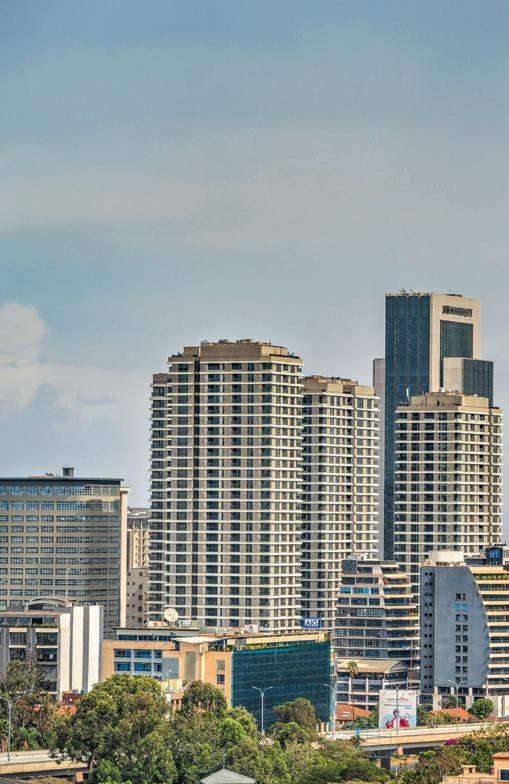
thrive, and shine, sometimes all in one Uber ride.
Q: What do you miss most about the city when you are away?
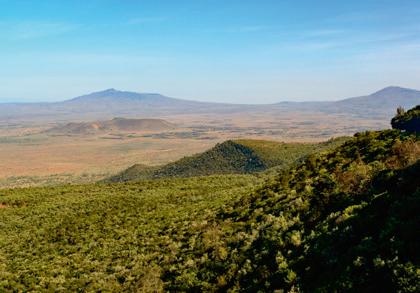
Kenyans always say: “Why would you even move from Kenya?” And it hits different when you’re far from Nairobi. This city emancipates joy, chaos, and creativity in equal measure. I miss the accents, the roadside drama, the music on every corner. Nairobi isn’t just a place, it’s a presence.
Q. When you are hungry, what is your favourite local delicacy to sample?
Nyama choma, No forks, no pretence. And if you bring me proper Kikuyu mukimo [traditional Kenyan side dish of mashed potatoes and green vegetables] soft and green with some charred meat on the
View of the Great Rift Valley Escarpment between Lake Naivasha and Nairobi
The Global Trade Center (GTC)
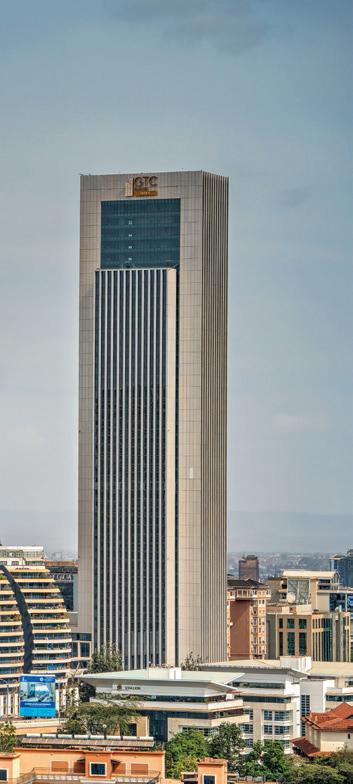
side, we’re officially friends. That combo? It’s comfort, heritage, and home on one plate.
Q: Where is your favourite place to escape into nature in the city? Not quite in the city, but my escape is the Nairobi to Naivasha Viewpoint. You see the Rift Valley stretch before you, Mt Longonot peeking through the clouds, and Lake Naivasha shimmering in the distance. Add a few coffee stops, a roadside chat or two, and you’ve got peace served scenic.
Q: Can you offer any advice on how to successfully use the city’s matatu mini-bus network? Matatus are Nairobi’s version of a party bus meets roller-coaster. I love their vibe, just don’t expect silence. Pro tip: Always ask the conductor where it’s going, sit close
to the exit if you’re not sure of your stage, and don’t be shy. Nairobians will help you if you look lost.
Q: Where would you recommend visiting to see the real Nairobi?
Right now, the art scene in Ngara. It’s turning Nairobi into a Bokaapstyle explosion of colour and creativity. You still feel the heartbeat of the city in Kibera and the everyday hustle of Eastleigh, but Ngara is where the new Nairobi is painting itself bold.
Q: Where do you go to find joy in the city?
Westlands, hands down. There’s always something new. A rooftop bar, a themed restaurant, or a hotel with a secret garden. It’s where Nairobi unwinds.
Q: What is your favourite building in the city?
The Global Trader Center (GTC). It’s not just a building, it’s Nairobi’s vision board. Sleek, sky-high, and proudly urban. The ‘I Love NBO’ inscription on the side is the city’s heli-selfie spot. Every New Year’s fireworks display from there feels like a promise. And the way it stands right next to the Expressway, it’s literally watching Nairobi race into the future.
Q: Nairobi has a thriving underground arts scene. Where are some of the best places to view art for emerging local artists?
Beyond the classics like Kuona Trust and Circle Art, I’m loving the Museum of Illusions. It’s playful, quirky, and perfect for creatives. Glass studio Kitengela Glass is also a must.
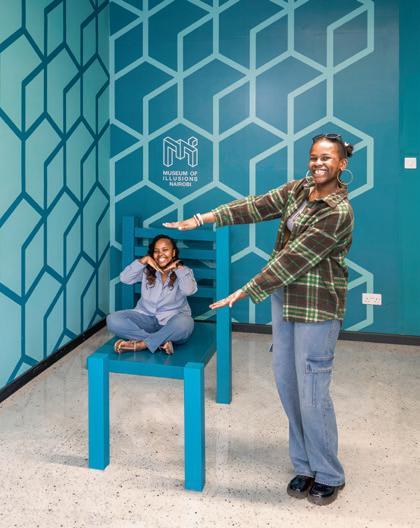
“I’m loving the Museum of Illusions. It’s playful, quirky, and perfect for creatives”
Q: If you are up for a late night, where do you go in Nairobi to party?
Let’s talk about the Kiambu Road stretch to Northern Bypass. Habanos is the current hot spot. Music, crowd, and vibe are unmatched. Bla Bla Nairobi is for when you want premium vibes with zero guesswork. And of course, K1 is eternal. It’s like Nairobi’s cool cousin that never ages.

To keep up with Adam's adventures and travel recommendations, visit his Instagram page @adammaina
Glass studio Kitengela
Africa’s food revolution is here
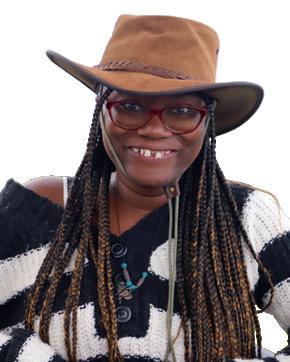
Harriet James

When Arusha recently hosted the United Nations World Tourism Organization’s (UNWTO) Regional Gastronomy Forum it wasn’t just another event on the global tourism calendar: it was also a moment of awakening.
I had the privilege of attending the event and for the first time East Africa took centre stage in a global conversation about the power of food as a cultural and economic driver. Chefs, policymakers, tourism stakeholders, and creatives from across the continent gathered to showcase cuisine, and affirm that, beyond heritage, African food is an untapped frontier.
The Middle East and Africa culinary tourism market is predicted to reach US$5.6 billion by 2030, highlighting the significant opportunities for African travel businesses to capitalise on the increasing global interest in unique and authentic culinary experiences.
Still there are challenges. One discussed at the UNWTO forum was the lack of global visibility and branding for African cuisine in comparison to Italian, Thai, and Japanese dishes, which seem to be everywhere. In my experience,
most hotels in East Africa prioritise international dishes on their menus as opposed to classic African favourites.
Then there is our continent’s diversity. In many ways it is a blessing, but it means there is no single narrative or signature dish that represents Africa making marketing difficult.
African cuisine
Other challenges? Cultural bias and colonial legacy have in a way resulted in African cuisine being overlooked even by the locals themselves who look down on their food and elevate international cuisine. Consequently, this has influenced what gets featured in global culinary media, restaurants, and even culinary schools.
Another obstacle is that there is minimal investment in Africa’s food value chain – from food processing and packaging to chef training and international promotion. This limits the ability of African restaurants and food businesses to scale and compete globally.
Then there is the way Africa has been traditionally marketed with the emphasis on beaches, safaris and wildlife. Culinary and cultural tourism gets sidelined. This
Paa columnist Harriet James is a Nairobi-based travel journalist who loves to promote African destinations, meet new people and inspire change and positivity wherever she goes. Follow her on Instagram and LinkedIn @HarrietOwalla.
has slowed the promotion of Africa's food heritage as a standalone attraction something that tourism ministers at the event vowed to change.
Farmers and chefs are also on the fringes, even though they are the ones who are the heartbeat of Africa’s culinary identity. Farmers provide the raw, often indigenous ingredients that form the foundation of authentic African cuisine, and their knowledge of sustainable, seasonal agriculture ensures not just food security, but culinary diversity that is rooted in place and tradition.
Chefs, on the other hand, are the storytellers. They take these ingredients and transform them into experiences that can travel across borders and palates. They need to be championed if Africa is to become a serious player on the global gastronomy map.
As ever it is African youth that is working to change the narrative. Content creators are spreading the international word on local hotels, entrepreneurs and restaurateurs to redefine Africa’s place at the global table.
Paa Royal Benefits
Benefits that will make you feel like royalty

Precision Air is always looking to give its customers an exclusive and memorable service experience; and the Paa Royal benefits programme is part of that mission. The membership categories* are as follows:

Jade Member benefits
Upon enrolment, members will be given their unique Paa Royal number, which they must always show whenever they buy tickets as well as during check-in at the airport. After flying three times or more, members will be given a Jade membership card. With the card, they will be recognised as members of the Paa Royal Programme.
Other benefits of Jade membership:
• Priority membership baggage tags to ensure tagged bags will be handled with special care and delivered first on the conveyor belt at the passenger’s arrival destination
• An opportunity to get a free ticket within the Precision Air’s network after accumulating enough points in their account.
*Please note that, in each membership category, if a member is unable to maintain the required number of flights in a year, he or she will be downgraded to their tier level achieved in that current year.

Silver Member benefits
After attaining Silver membership level, the member will be issued with a Silver membership card which he (or she) must show at all Precision Air point of sales in order to receive the recognition that he deserves. Should a member book online by logging into Paa Royal Pages, he will automatically receive points earned to his account. Members will be entitled to special treatment and priority treatment whenever they travel.
Other benefits of Silver membership:
• Free 5 kg baggage every time member travels on a PW operated flight
• Priority membership baggage tags to ensure tagged bags will be handled with special care and delivered first on the conveyor belt at member’s arrival destination
• Opportunity to obtain a free ticket within the Precision Air network after accumulating enough points in your account
• Priority telephone reservation in those times when you want to make your reservation and cannot visit our office or travel agent. Booking is a call away through our Paa Royal helpdesk line.

Gold Member benefits
After attaining the Gold membership, members will begin to experience royal and exclusive treatment whenever they fly. Members will be opened up to a new world of opportunities and experiences and, of course, receive more rewards. Should a member book online by logging into Paa Royal Pages, he (or she) would automatically receive points earned to his account.
Other benefits of Gold:
• Free 10 kg baggage every time member travels on a PW operated flight
• Priority membership baggage tags to ensure tagged bags will be handled with special care and delivered first on the conveyor belt at member’s arrival destination
• Opportunity to obtain a free ticket within the Precision Air network after accumulating enough points in your account
• Priority telephone reservation at times when you want to make your reservation and cannot visit our office or travel agent. Booking is a call away through our Paa Royal helpdesk line
• Priority waitlist/airport standby each time you want to travel and your selected flight is full.

Tanzanite Member benefits
When members reach Tanzanite member they attain ultimate royalty. We will always strive to give these royal members an exclusive and memorable flight experience. At this level, members will already be used to royal treatment; royalty will be their way of life.
Other benefits of Tanzanite:
• Free 15 kg excess baggage every time the member travels on a PW-operated flight
• Opportunity to obtain a free ticket within the Precision Air network after accumulating enough points in your account
• Confirmation on any flight if a member is prepared to pay Y class fare, regardless of the flight booking status
• Priority waitlist/airport standby whenever you want to travel and your selected flight is full
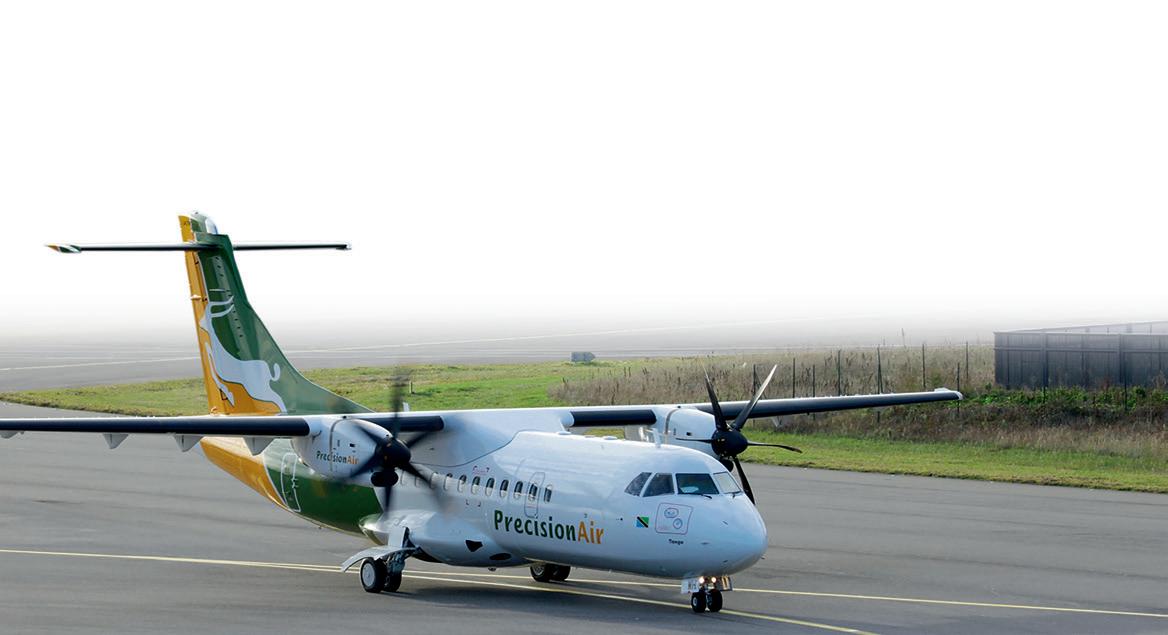
• Priority telephone reservation at times when you want to make your reservation and cannot visit our office or travel agent. Booking is a call away through our Paa Royal helpdesk line.
• Priority membership baggage tags to ensure tagged bags will be handled with special care and delivered first on the conveyor belt at member’s destination.
• Silver, Gold and Tanzanite members also get discounts of up to 20 per cent when visiting GSM shopping malls Msasani and Pugu, Southern Sun Hotel, Akemi restaurant, East Point Restaurant and the Colosseum hotel and sports club - all in Dar es Salaam.
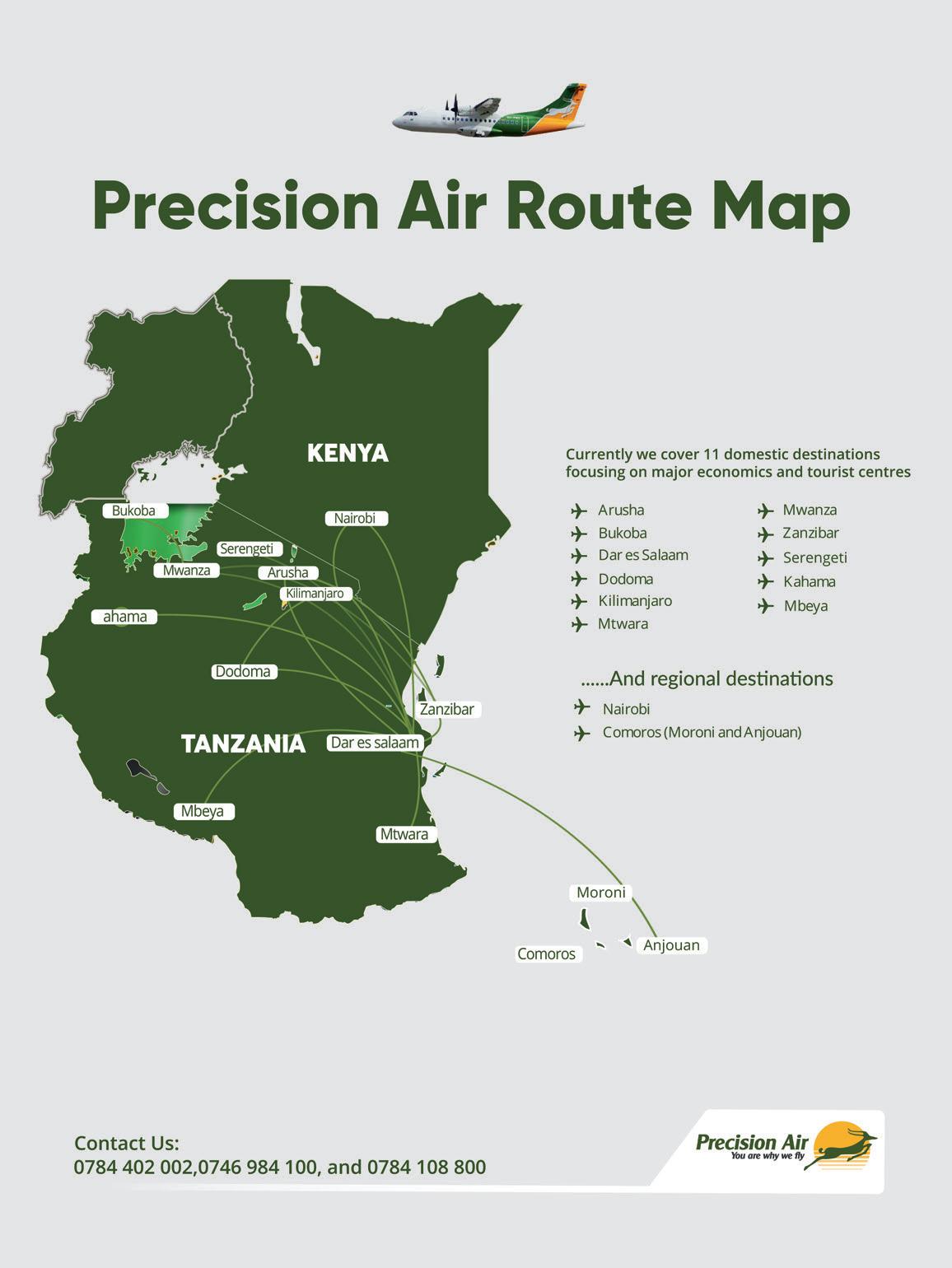
Paa Contacts
Your nearest Precision Air office anywhere in the world
TANZANIA
Dar es Salaam Head Office
Diamond Plaza, 1st Floor, Plot no 162 / 38, Mirambo Street/ Samora Ave, Dar es Salaam
Tel: +255 (0)22 219 1000
Contact Centre:
+255 (0)787 888 409/408/417
Email: pwreservations@precisionairtz.com
Dar es Salaam Sales Office
NIC HDQ BUILDING,
Samora Ave/Pamba Road
PO Box 70770, Dar es Salaam
Tel: +255 (0)22 213 0800 / 212 1718
Fax: +255 (0)22 211 3036
Email: salesdar@precisionairtz.com
E-COMMERCE
(For users of VISA and MasterCard)
Diamond Plaza, 1st Floor
Plot no 162/38
Mirambo Street/Samora Ave
Dar es Salaam
Tel: +255 (0)686 177 458/ (0)689 669 446
Fax: +255 (0)22 211 3036
Email: pwreservations@precisionairtz.com
ARUSHA
Ngorongoro Tourism Center
First Floor
Goliondoi & Makongoro Road
PO Box 1636, Arusha
Tel: +255 27 254 5489 / 254 5503
Email: pw-arksales@precisionairtz.com
BUKOBA
Bukoba Office-GSA, Bukoba Machinery, Bukoba Centre
Kawawa Road, Bukoba
Tel: +255 (0) 28 222 0545/222 0204
Mob: +255 (0) 713 316 806/ (0) 787 616 806
Email: bukobamachinery55@yahoo.com
DODOMA
Mtendeni street, Dodoma
Tel: +255 787 845 200 / 754 972 173
MOSHI
KNCU Building, Ground Floor
Old Moshi Road, Moshi
Tel: +255 784 686 418
+255 (0)272 753 495/753 498
Mob: +255 (0)787 800 820
Email: sales@acobtravel.com info@acobtravel.com
MTWARA
Tanu Road, Posta Building
PO Box 1066, Mtwara
Tel: +255 (0)23 233 4116
Mob: +255 (0)787 818 442/ 767 818 442
Email: pw-mwzgsa@precisionairtz.com
MWANZA
Along Kenyatta Road, Plot no 002, Mwanza
Tel: +255 (0)28 250 0819/250 0204
Fax/Tel: +255 (0)28 250 1054
Mob: +255 (0)784 402042
Sales Office Mobile: +255 (0)784 968427
ZANZIBAR
Zanzibar Airport
Tel: +255 (0)24 223 4521
Fax: +255 (0)24 223 4520
Email: pwznz@precisionairtz.com
KENYA
NAIROBI
Barclays Plaza, 7th Floor, Loita Street
PO Box 50990-00100, Nairobi
Tel: +254 (0)20 327 4282 / 4290 / 4297
Mob: +254 (0)724 76 0736 / +254 (0)736 046 595
Airport: +254 (0) 733 934 795 / 731 530 000
Email: pw-nbo@kenya-airways.com
SOUTH AFRICA
AIRLINEPROS
Airport Office: OR Tambo Airport
Terminal A, PSC24, Johannesburg, South Africa
Town office: 27 Neeron Road, Randburg, Johannesburg, South Africa
Tel: +27 (0) 10 880 6480
Email: PrecisionAir.ZA@airlinepros.net
UGANDA
Pan Africa House
Plot no.3 Kimathi Avenue
PO Box 5619, Kampala
Tel: +256-790 381 431 (24hr Emergency)
Mob: +256 784(704) 329 793
Email: precisionair.eva@utb.co.ug
AUSTRIA
Argentinierstrasse 2/4
A-1040 Vienna, Austria
Tel: +43 1 585 3630
Fax: +43 1 558 536 3088
AUSTRALIA
Suite 1302, 109 Pitt Street
Sydney, Australia
Email: helpdesk@apg-ga.com.au/ australia@apg-ga.com
BELGIUM
Park Hill, J.E Mommaertslaan 18B
1831 Diegem, Belgium
Tel: +32 (0)2 712 0584
Fax: +32 (0)2 725 8392
Mobile: +32 (0)47 770 9971
FINLAND
Precision Air C/o Aviareps
PL 10 00750 Helsinki, Finland
Tel: +46 8 5556 9162
Email: PWres.scan@aviareps.com
FRANCE
Precision Air, 11 rue Auber
75009 Paris, France
Mob: +33 (0)6 21 824 908
Reservation: +33 (0)1 534 35397
Fax: +33 (0)1 5343 7919
GERMANY
MUNICH OFFICE
Josephspitalstrasse 15 80331 Munich
Germany
Tel: +49 (0)895 525 3373
Fax: +49 (0)895 450 6842
FRANKFURT OFFICE
Kaiserstrasse 77 60329 Frankfurt / Main
Germany
Tel: +49 (0)69 770 673 010
Fax: +49 (0)69 770 673 018
GREECE
7 Stadiou Street, Athens 10562 Greece
Tel: +30 (0)210 9341 500/501
Fax: +30 (0)210 934 1620
Email: PrecisionairSales@tal-aviation.gr
IRELAND
Precision Air GSA APG Ireland
27 Lower Ormond Quay Dublin, Ireland
Reservations: +353 (0)1 804 5100
Email: precisionair@apg-ga.ie
NETHERLANDS
Beechavenue 104 1119 PP Schiphol, Netherlands
Tel: +31 (0)20 520 0280
Fax: +31 (0)2 6 23 0151
SPAIN
Bravo Murillo 101, Planta 6 Oficina 3, 28020 Madrid, Spain
Tel: +34 (0)91 458 5560
Fax: +34 (0)91 344 1726
Email: Precisionair.spain@aviareps.com
SWEDEN
Aviareps, Riddargatan 17 11457 Stockholm
Sweden
Tel: +46 (0)8 5556 9162
Email: PWres.scan@aviareps.com
SWITZERLAND
Badenerstrasse 15, 8004 Zurich
Switzerland
Tel: +41 (0)44 286 99 60
Fax: +41 (0)44 286 99 00
Email: precisionair-switzerland@aviareps.com
TURKEY
Discover The World -Turkey
Nef22 E Blok 13. Kat No:194
Atakoy/ İstanbul 34156 TURKEY
Tel: +90 212 806 11 87
Email: info@discover-tk.com/ sales@discover-tk.com
USA and CANADA
AirlinePros
420 Lexington Ave
Suite 358-360
New York, NY 10170
Tel: +1 877 496 9887
Email: reservations@precisionairlines.us Precisionair_tanzania@airlinerpos.ca
UNITED KINGDOM
APG Global
Highbridge House, 581 Bath Road Longford, West Drayton
Middlesex, UB7 0EW
Reservations: +44 (0)844 482 2313
Email: precisionair@apg-ga.co.uk
MASTER GSA OF ASIA
PACIFIC (excluding Japan and China)
Elite Holiday Travel Service
Taipei, Taiwan
FAX: 8
Tel: 886-2-2541 3366
Fax: 886-2-2536 1824
Email: sales@eliteholiday.com.tw
PRECISION AIR OFFLINE TEAM
Diamond Plaza, 1st Floor
Plot no 162/38, Mirambo Street
Samora Ave, Dar es Salaam, Tanzania
Tel: +255 784 772 823 / +255 786 447 411
Email: pw-offline@precisionairtz.com
Welcome Aboard
Safety and well-being on board
PASSENGER SAFETY
Precision Air takes passenger safety very seriously. Aviation safety isn’t just the pilot’s or the cabin crew’s job – it takes all of us.
It is easy for our natural sense of caution to be dulled in our modern environment, where things don’t go wrong very often. Whether in the air or on the ground, your life and the lives of your family members could some day be saved if you make it a point, in every situation, to create a mental plan of action in case of emergency. Here are some important tips to help you enjoy your travel experience with Precision Air – in flight and around the airport.
EXIT ROW SEAT
A passenger who is allocated an emergency exit seat:
A. Must be both willing and physically able to open the exit doors in an emergency
B. Must completely understand the printed emergency evacuation techniques
C. Must be 16 years old and above.
PAY ATTENTION TO PRE-FLIGHT BRIEFING
Although the information seems repetitious, the locations of the closest emergency exits may be different depending on the aircraft that you fly on and the seat you are in.
CARRY ON BAGGAGE
There are strict rules about what you can bring on board an aircraft. Because:
A. Not all aircraft have space to store your carry-on baggage.
B. In an accident, baggage in the aisles makes it harder to get out of the aircraft quickly.
Carry-on bags must be small enough to fit under the seat in front of you or in the overhead bins. Please confirm with Precision Air rules before your travel to avoid delays.
*Remember: All carry-on baggage must be left behind in an evacuation.
SAFETY ONBOARD
Boarding and leaving an aircraft requires your full attention. As you move to and from the aircraft, you may be in a busy area with many other passengers and cargo, moving vehicles, other aircraft, slippery walkways and/or stairs.
RESPECT YOUR CREW AND FELLOW PASSENGERS
Everyone has the right to safe and secure travel. That is why Precision Air employees and the aviation authority will not tolerate any behaviour that interferes with the flight or puts the safety of passengers and crew at risk.
SEATBELTS
Seatbelts must be fastened during take-off, landing, during turbulence and any time the crew deem it necessary. Keeping the belt on when you are seated provides that extra protection you might need in case of emergency. If you are responsible for an infant or a child, you must first ensure that your own seatbelt is properly fastened, then secure the child and, if it is an infant, secure the child’s or the infant’s restraints.
Important note: There are a number of events involving air turbulence that highlight the importance of keeping seatbelts fastened throughout the flight.
Though rare, in-flight turbulence is the leading cause of injuries to both passengers and crew.
Fly with a face mask
For the your own safety and the safety of your fellow passengers and crew, we ask you to wear a face mask during the entirety of your flight today. Thank you!
You Are Why We Fly
It’s a good idea to keep your seatbelt fastened even when the seatbelt signs are not on.
MEDICAL CONDITIONS AND PREGNANCIES
If you have a medical condition and may need assistance during your travel, kindly ask the Precision Air offices or agents about procedures before your flight. If you are pregnant, you will need to fill a Precision Air medical form, to be signed by your doctor, to confirm that you are OK for travel. For further details, kindly ask while booking your ticket from our sales offices and/or customer services.
PORTABLE ELECTRONIC DEVICES
Use of portable electronic devices such as mobile phones, laptops, tablets, MP4 players, iPads, etc are not allowed during take-off, landing, taxiing, descent and climb.
Precision Air prohibits the use of some electronic devices during flight because they emit signals that can interfere with the aircraft's instrumentation. Some of the items prohibited include cellphones, radios, remote-controlled games/toys, laser pointers, iPads or tablets that transmits frequencies, portable printers, walkie-talkies, scanners and laptops. These items need to be stowed away for these phases of the flight to avoid injuries in case of an emergency.
